M.S. Bloemfontein (2) 1934 to 1959 & M.S. Jagersfontein (2) 1934 to 1942
Please Note: Firefox and some other Search Engines may not be suitable
Use Google Chrome for this Web Page to load perfectly!
Please
Note: All ssMaritime and other related maritime
sites are 100% non-commercial and privately owned, thus ssmaritime is NOT
associated with any shipping company or any other organisation! Although the
author has worked and been involved in the passenger shipping industry for well
over 60 years, but due to his old age and poor health, he was forced to retire.
Yet, he has completed well over 1,435 Classic Liners, Passenger-Cargo Liners as
well as humble converted C3 converted Migrant Liners, which has transported
countless thousands of folk to the new world, as well on vacations’. I
trust the features online will continue to provide Classic Liner and Ship
enthusiasts both the information they are seeking, but more so provide a great
deal of pleasure and relive many happy memories!
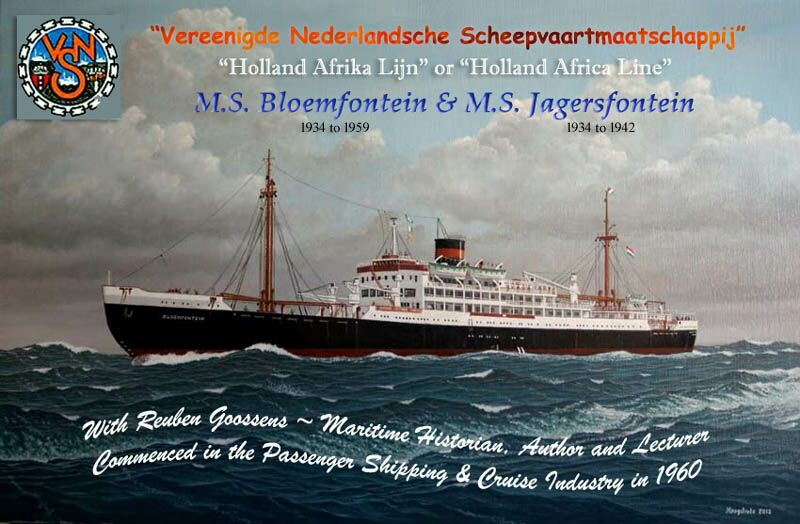
The painting above shows the M.S. Bloemfontein after her WW2 refit
Please Note: Postcards, photographs & other images are either from the author’s private collection or from my supporters.
Thus a very special thank you to five very special ssmaritime supporters for sending me their wonderful
Photographs & images for I could not have completed this feature to this point.
I am sorry
but some of the images shown may not be of the highest quality, but they are
the best that are available.
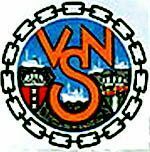
The “V.N.S.” Logo
Also known as: “Holland Afrika Lijn” or “Holland Africa Line”
PAGE ONE
For interest, the company was originally formed in 1919 as the “Nederlandsche Zuid-Africaansche Scheepvaart Maatschappij” - (NZASM). However in 1932 NZASM’s interests were completely taken over by the “Vereenigde Nederlandsche Scheepvaartmaatschappij” - VNS (“United Netherlands Steamship Company”), which was officially founded in April 1920 as a unique partnership of eight of the major Dutch Shipping Companies. The VNS grew into a major shipping company with many large freight and passenger cargo ships in operation. This made it one of the largest European shipping companies.
However, the original (NZASM) then VNS traded under the popular name of “Holland Afrika Lijn” and their ships were given a new livery of black hulls with a red boot topping and a distinctive dark orange band on their black funnels.
In 1929 the 6,280 GRT (Gross Registered Ton) S.S. Nieuwkerk was built, with a traditional bow, however in 1934 she was considerably rebuilt with the following changes, 1, for her to become a passenger ship with accommodations for 80 First Class passengers, and 2, the former cargo ship was lengthened by about 20 m, and 3, she was fitted with a Maierform-bow (named after its inventor Mr. F. F. Maier, 1844-1926), and 4, she had become a motor ship having had her engines replaced to cut costs. When completed she was renamed the “Boschfontein” and she was reregistered as being 7,139 GRT. Both versions of this ship can be seen below. She joined the new ships on the VNS African passenger services.
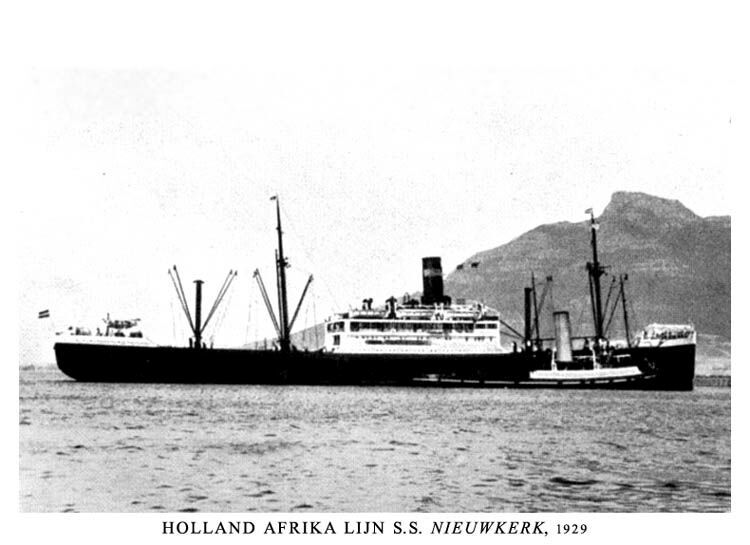
The 1929 completed
S.S. Nieuwkerk (
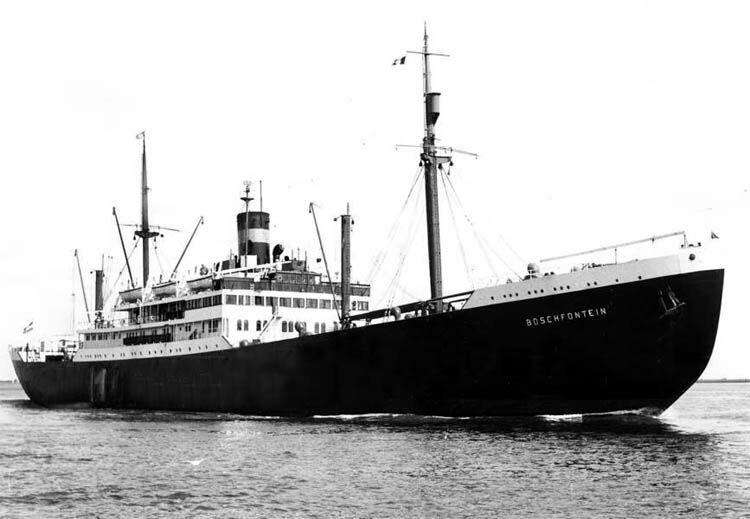
And here she is again as the rebuilt M.S. Boschfontein with a Maierform bow
The Maierform-bow became the very latest vogue at the time, especially on Scandinavian ships as well as a number of VNS ‘fontein’ ships, for it certainly improved and reduced a ship’s movement through the water.
Two New Larger Sister Ships:
The company adopted a go-ahead policy despite
the depression VSN ordered two new larger Passenger-Cargo motor Liners of over
10,000 GRT to be completed by 1934. They would be named “
The
Both these new ships would accommodate 81
First Class and 32 Third Class passengers on their respective services to and
from
The “
*********************
Part One
M.S. Bloemfontein (2):
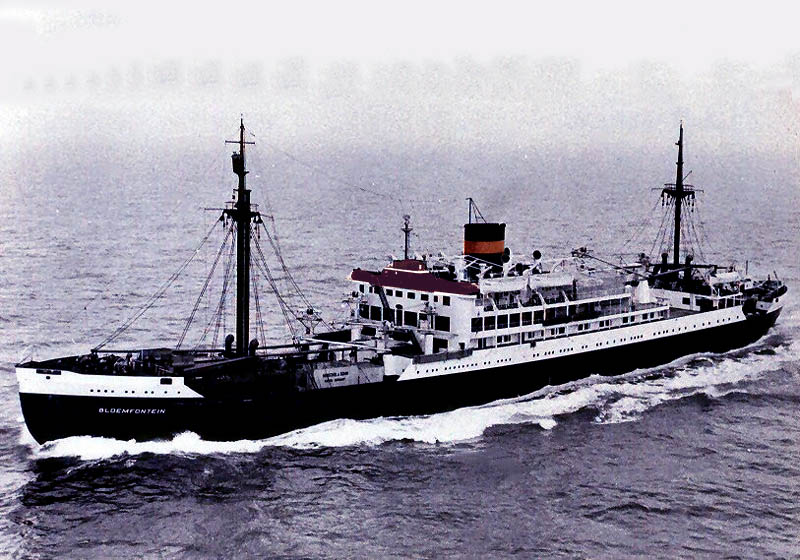
Here is a fine
aerial photograph of the M.S. “
With plans laid and both ships having been
ordered to be built by the “Nederlandsche Scheepsbouw Mij,
NV” (“Netherlands
Shipbuilding Company”),
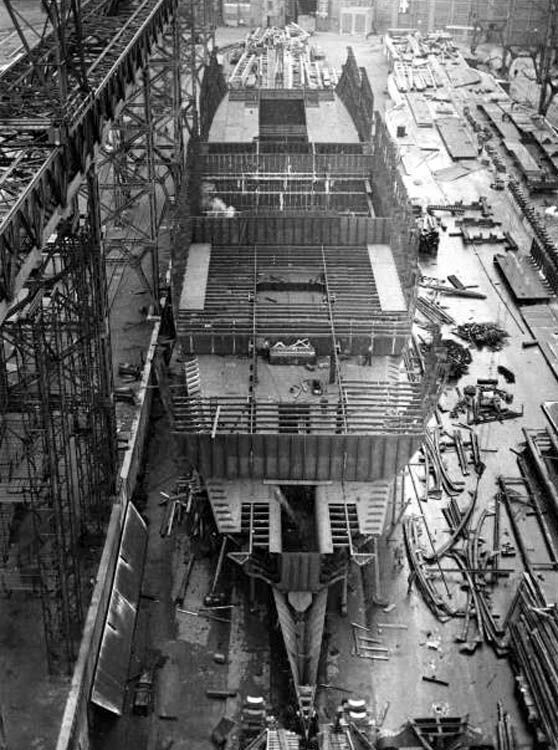
Her hull was well on the way early in 1934
It would be just ten months later that she was well and truly ready to be launched, and unlike the usual launching, this was far from the norm, as this was like nothing like anything else before it, for there was nothing normal about this launching as we will soon discover!
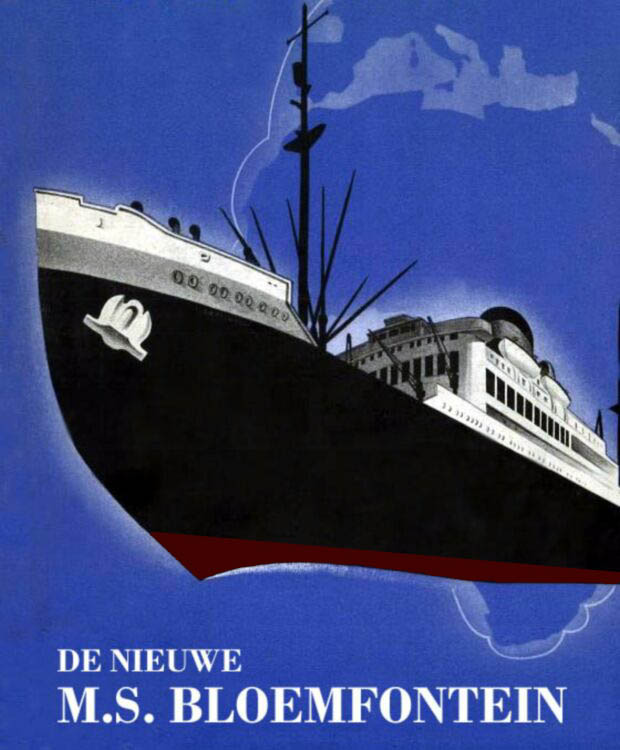
A promotional poster featuring “THE NEW BLOEMFONTEIN” - but in Dutch of course!
Just for interest, the Dutch word
‘Bloem’ means flower & ‘fontein’ is fountain, and
it does seem to be a rather strange name for a ship. However, it happens to be
the name of one of the three beautiful Capital Cities in
“Bloemfontein
In mid May 1934 “Nederlandsche Scheepsbouw Mij NV” had been advised the date that she would be able to be launched and that was on June 16, 1934, thus they sent out a beautifully printed invitation booklet to a large number of VIP’s, including of course many official’s including Government and City officials and the Media, etc, to this unique and very special launching ceremony. In addition a good number of those VIP’s would also be invited to join her when she would undertake her deep Sea Trials later in October.
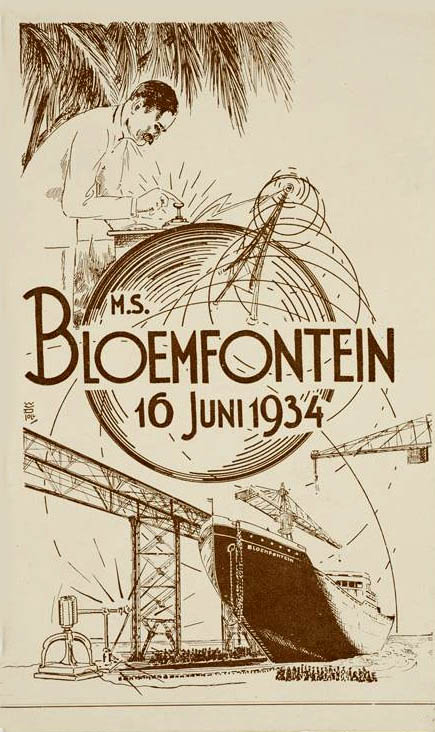
Cover of the Invitation booklet
The day had arrived, and it was going to be a
huge day. Not just in the
She was named in
As we were not given the precise details of how this worked, however I do have the information of how it worked for her sister ship the “Jagersfontein” just under a month later, and she was launched by the General Herzog himself. Thus all the details will be found in Part Two when I will cover the “Jagersfontein”.
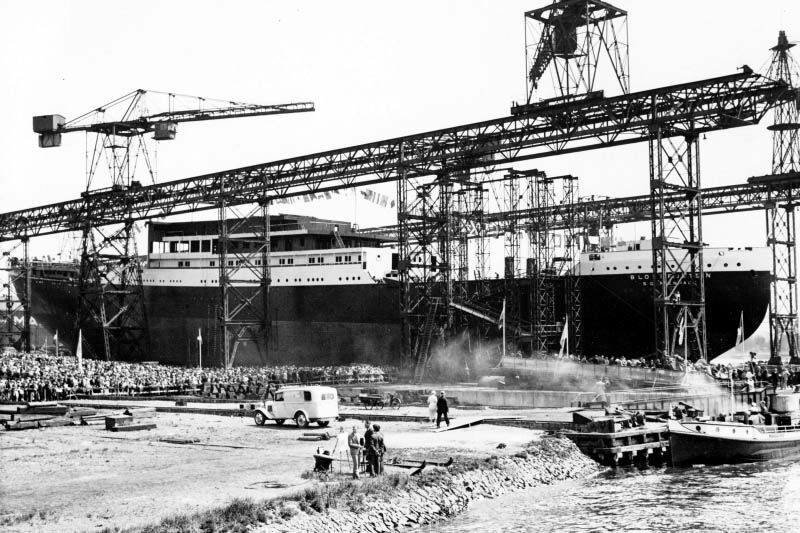
As can be seen,
there was a huge crowd at the launching of the “
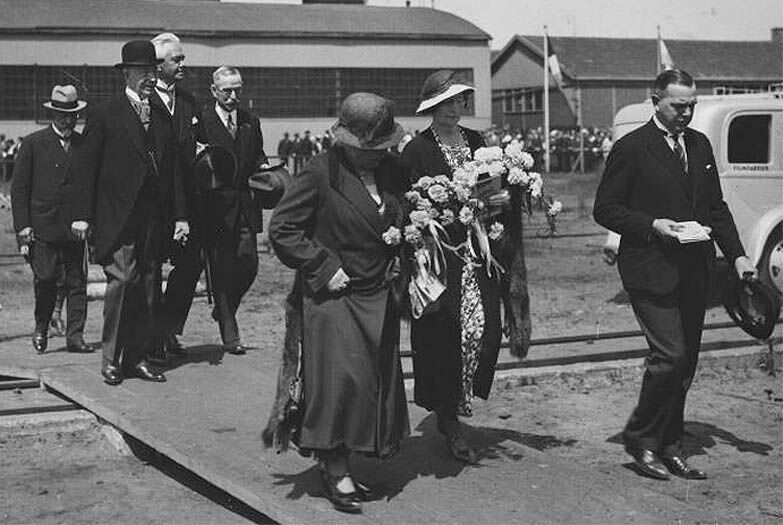
Above & below: Mrs. Hertzog and her husband General Hertzog and a special family member are
seen arriving at the chosen location in
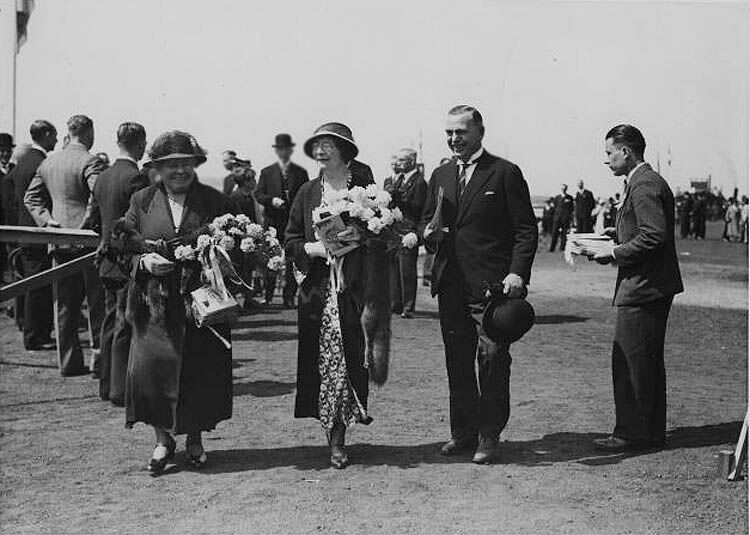
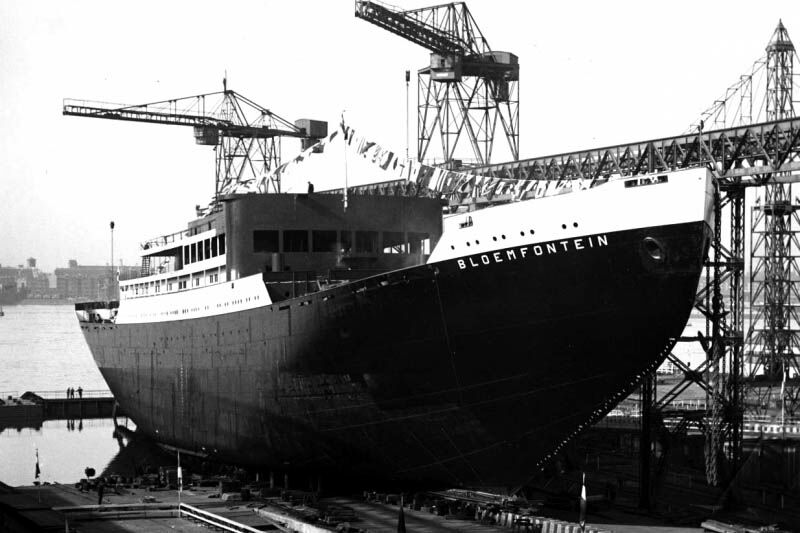
The link had been
pressed in
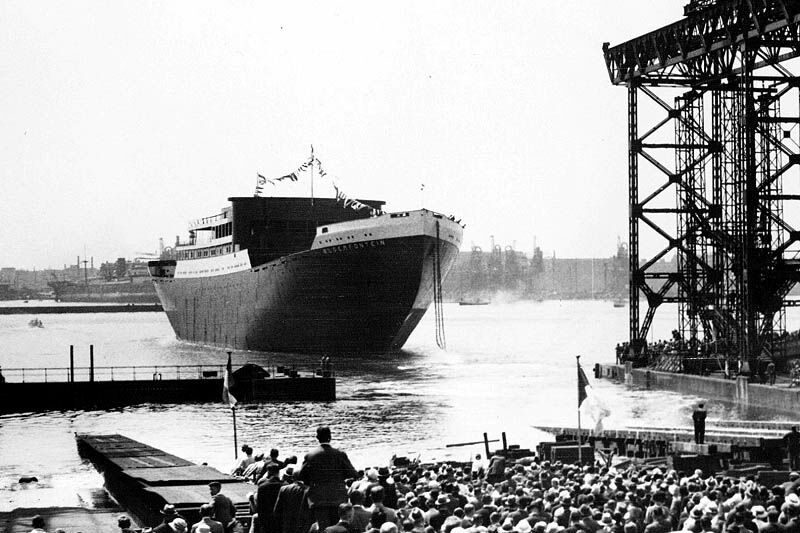
Above &
below: As the
in tow and she headed to the ship-yard’s Fit-out berth, where
she would be completed.
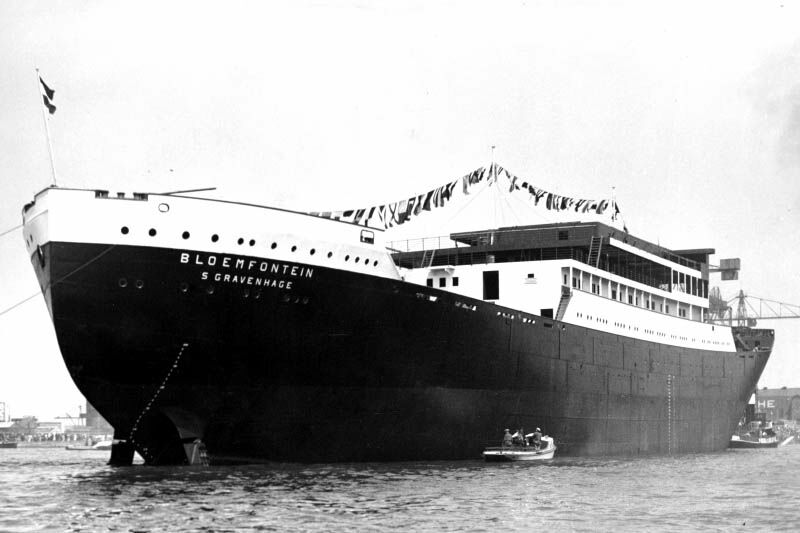
During her fit-out she still had to go into dry-dock as her propellers were to yet to be fitted, which was done on July 19.
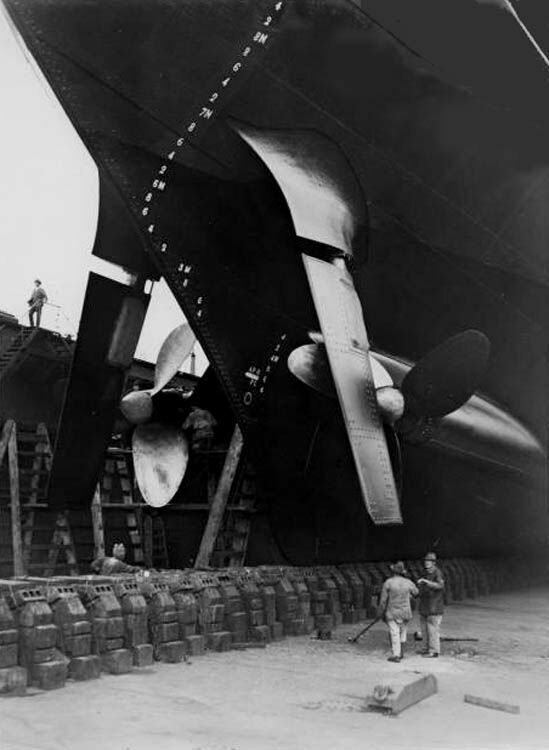
A view taken on
July 19, 1934 of her twin three bladed screws and her sister’s very
unusual rudder’s
Before her being
launched they just had to secure the rudders, for as she hits the water in
reverse they could be damaged
Her
Sea Trials:
She was completed on October 18, 1934, and two days later on the 20th she headed out on her Sea Trials, with a host of VIP guests on board.
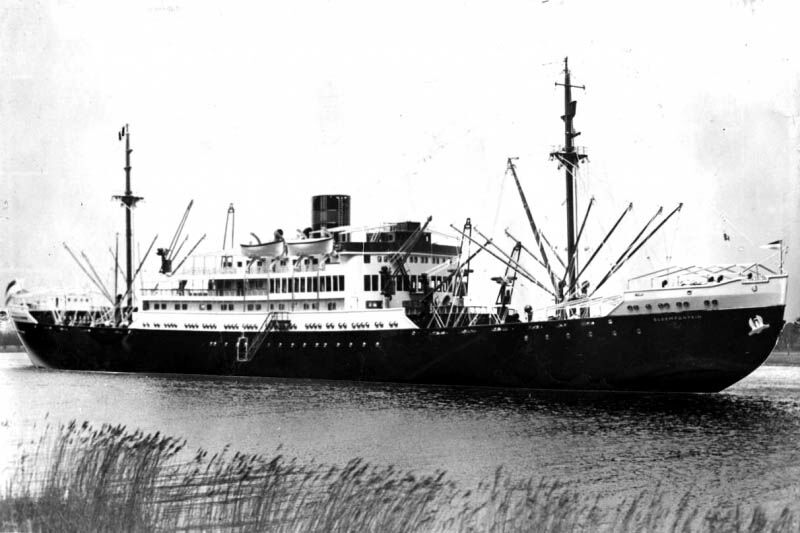
M.S. Bloemfontein
is seen heading down the ‘Noordzeekanaal’
(
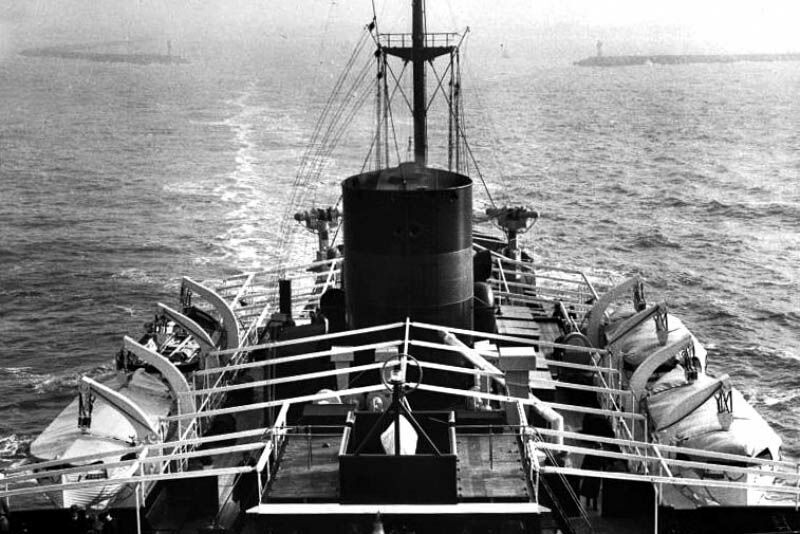
This photograph
was taken from the Crows Nest looking aft, taken during her Sea Trials
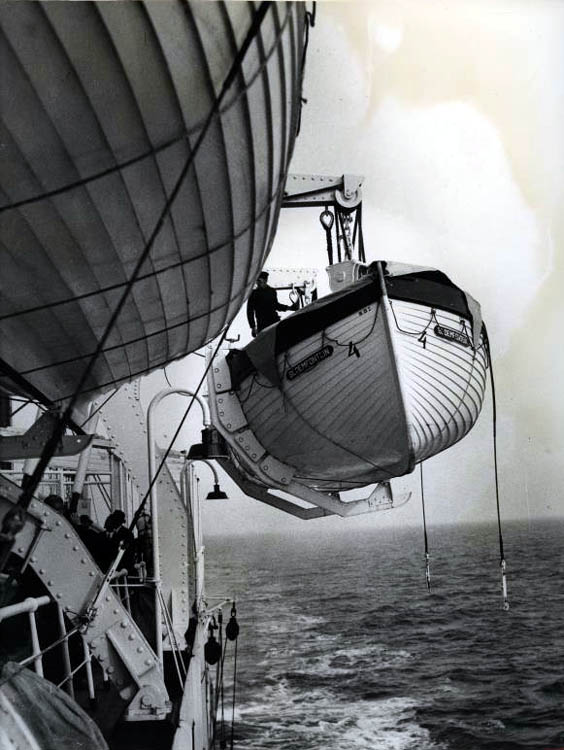
A lifeboat was swung out being one of the trials undertaken during her Sea Trial
Her trial was successful having attained a maximum speed of 17.3 knots, and when her Sea Trials was officially over she was then officially handed over by the builder to her owner as well as a handshake with the Captain, taking Command of the Ship officially and the Builders flag was lowered and the VSN – Orange, White & Blue House Flag was officially raised.

The VNS funnel and
official House Flag
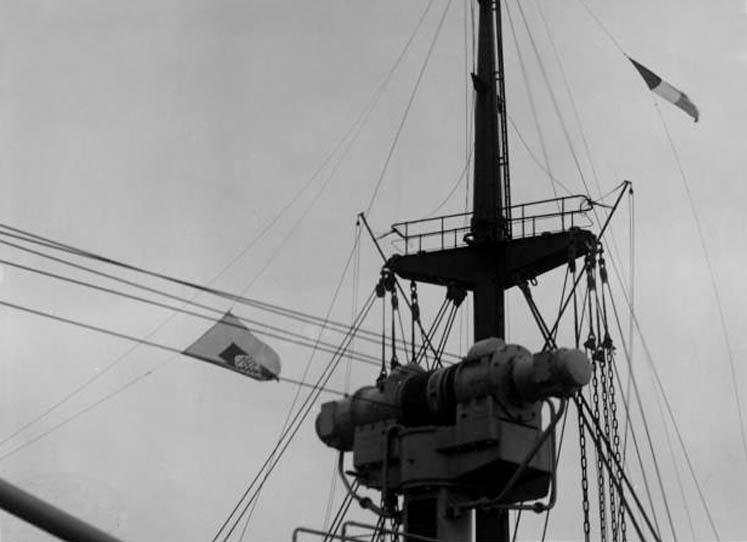
Above & below: We see the builder’s flag come down on the right and the VNS flag go up the mast
Then with the
shake of the hands with the CEO and the Captain the handover is officially
sealed
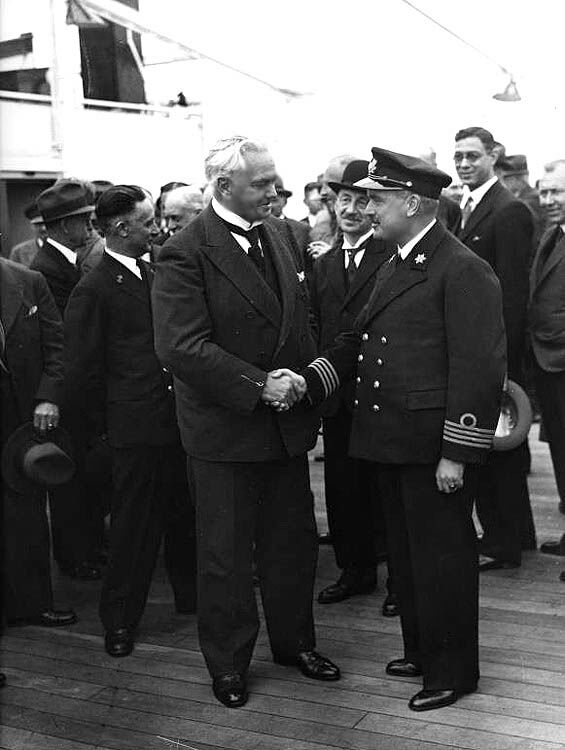
Thereafter it is time to have a drink and have
some of those tasty snacks prepared in the Galley and celebrate the occasion as
the ship heads for
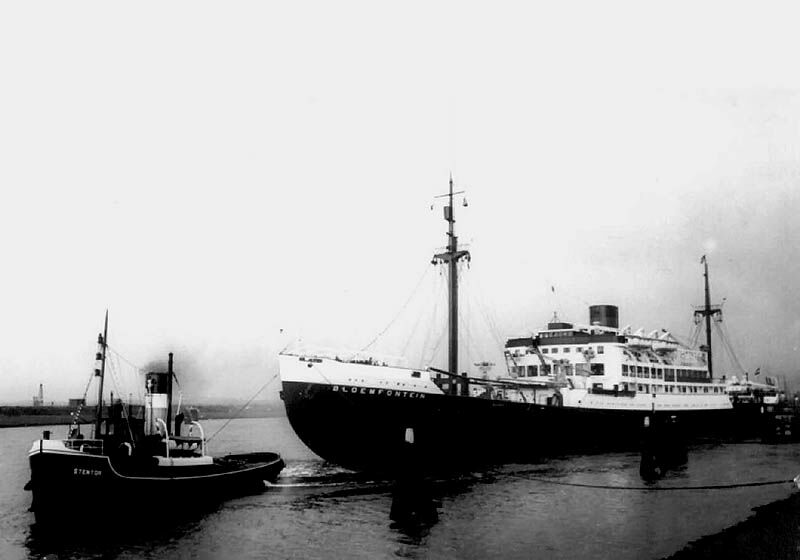
The “
Maiden Voyage:
In
Then came the big day all was ready and all
her passengers had boarded and were standing along the railings with family and
friends ashore, with the band playing, it is always an emotional moment as the
ship is about to sail as many on board are leaving for a new home and may not
be returning, whilst others are going to visit relatives, or are on a vacation.
The “
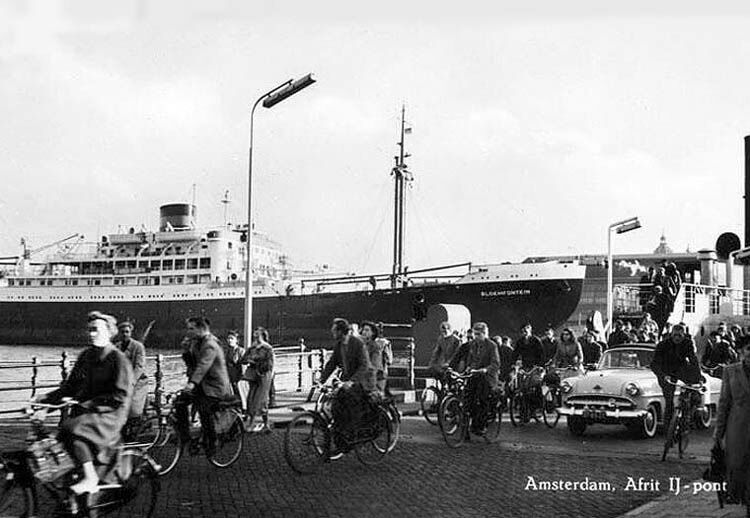
M.S. Bloemfontein
is seen departing
The building
behind her is the Central Railway Station, and the traffic is rolling off one
of the Ferries crossing the River IJ
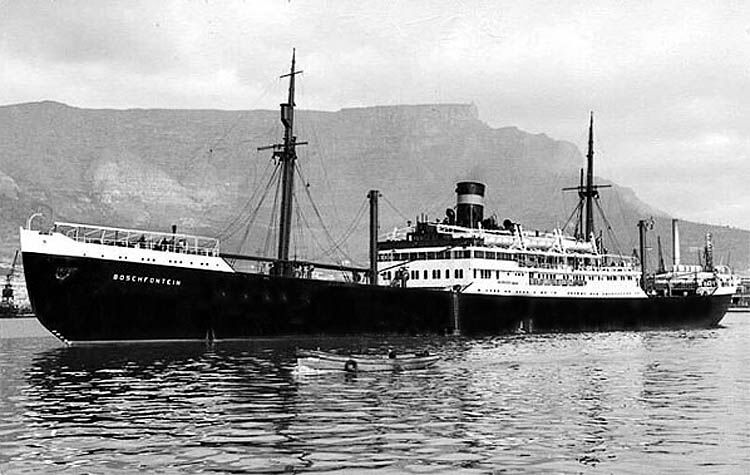
Here we see the M.S. Boschfontein operating on the African service along with the two sisters
The Ship’s Schedule:
Amsterdam, Antwerp - Belgium, Dover, *Cape Town, *Mossel
Bay, *Port Elizabeth, *East London, *Durban - *South Africa, ^Lourenço Marques (Maputo), ^Beira
- ^Mozambique Returning from; Beira, Durban, East London, Port Elizabeth, Cape
Town, Southampton Antwerp, Amsterdam.
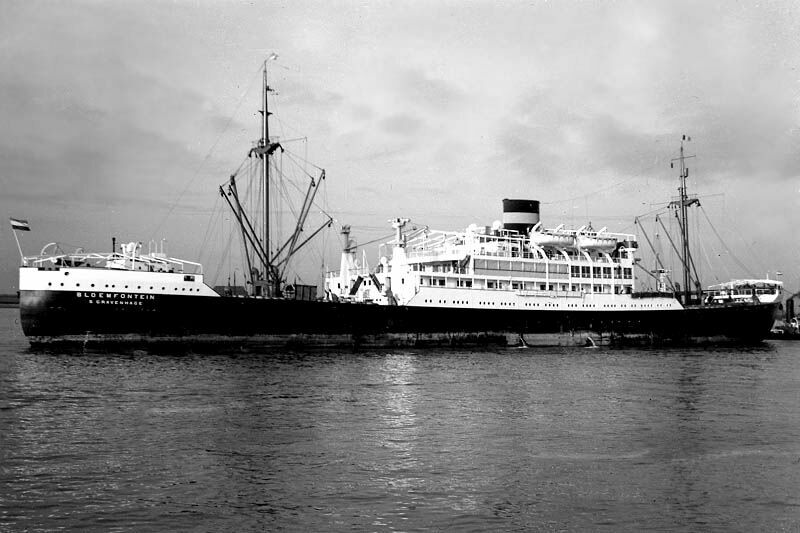
The “
Her Services Over the Next Years:
She continued her voyages successfully, except
during her return voyage from Africa, when arriving early on thick foggy
morning at
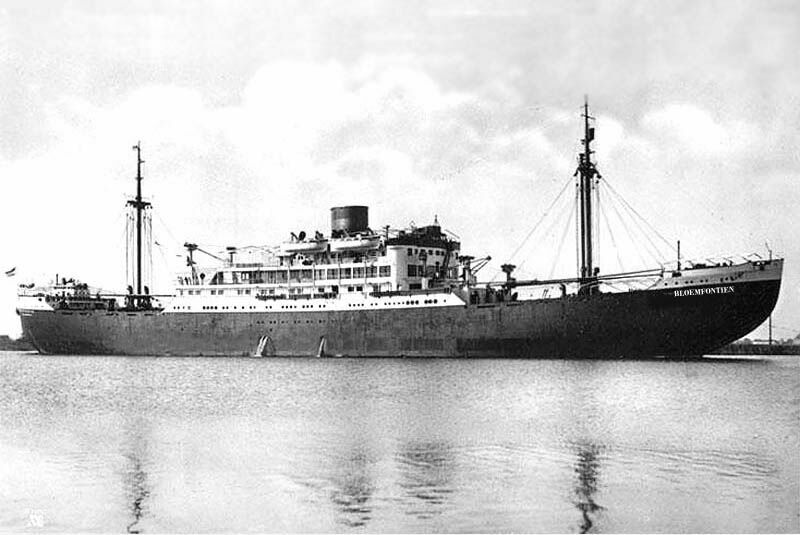
She is seen here in 1938 and soon her days would change completely
Her passengers enjoyed their time on her, as she and her sister became very popular ships, as the service and the cuisine on board proved to be simply excellent.
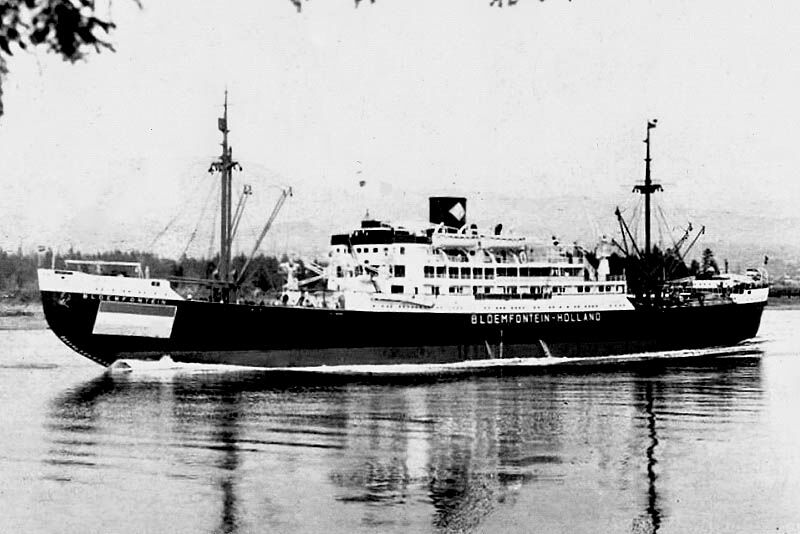
The “
But that did not matter to a madman like the worst murderer the world has ever known - Hitler”!
Thus even though she would join the
“Java Pacific Line” for a short time, that would end all too soon
as sadly she would soon become a ship of war.
*********************
Interiors
of both the Bloemfontein
Internally both ships were almost identical, except for slight differences when it came to paintings and images on board, but all public venues and accommodations were identical.
I will commence with several items of “Holland Africa Lines” promotional material.
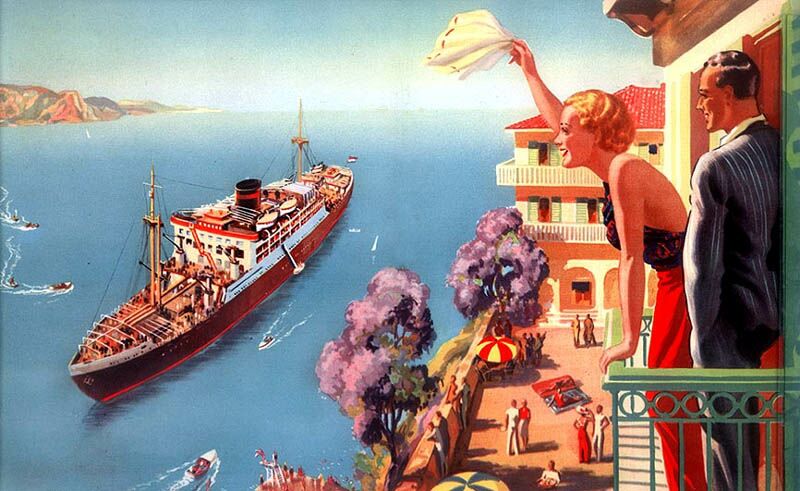
An image from one of their early brochures
Topside forward there is the most important location of the ship being the Bridge, for it is the location that keeps the ship heading in the right direction, here also is the Chart room as well as the Radio room, whilst the Captain quarters and the First and second officers rooms will be very close by!
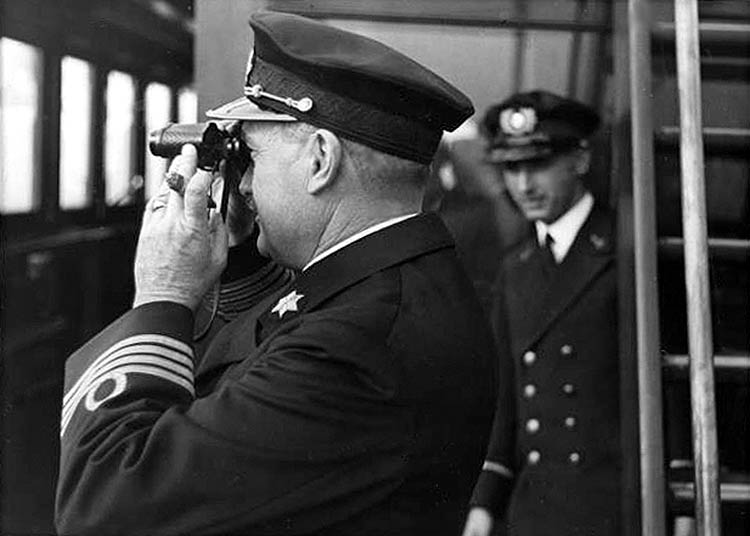
Here we see the Captain keeping an eye on what is ahead, whilst his helmsman will be keeping the ship on course
First Class:
Although I will not be mentioning decks in this feature as I have been unable to locate a Deck Plan, but I do know from the aerial ship photographs that aft on what would be Boat Deck there was a separate a reasonably spacious Sports deck with all the facilities required for whatever sport the guests desire to play. This area could be covered or be open pending the weather.
One deck down there was a Lounge and on the starboard side just aft there was the Bar, whilst on portside was a combined Writing and Reading Room, whilst aft on was the beautifully timbered Smoking Room. Outside there was an excellent wide U shape Promenade Deck.
Please note:
Some of the coloured photographs below are from the “
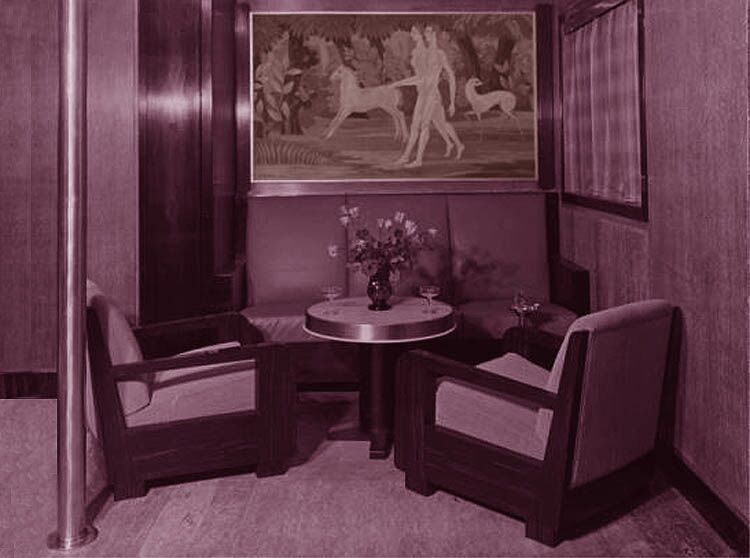
A small corner of
the Main Lounge
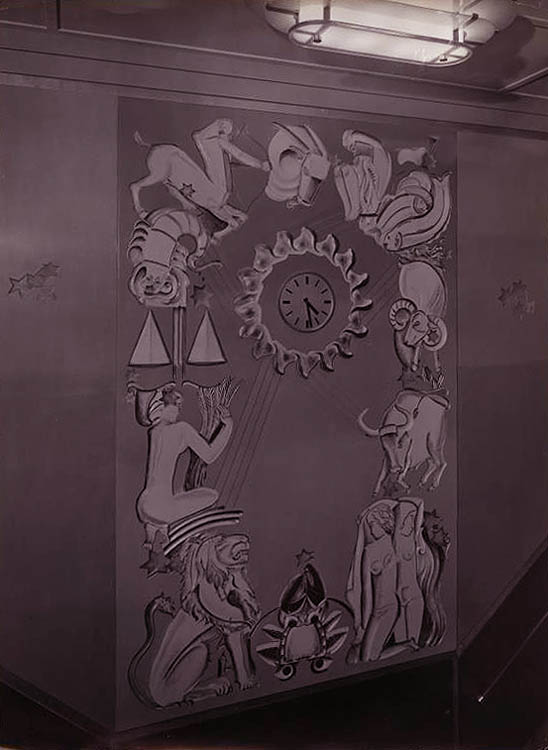
A Mural found in
the Main Stairwell
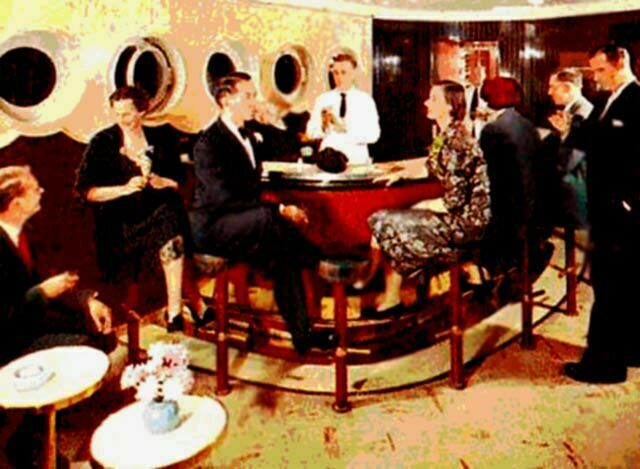
Here we see the
ships Bar (post war)
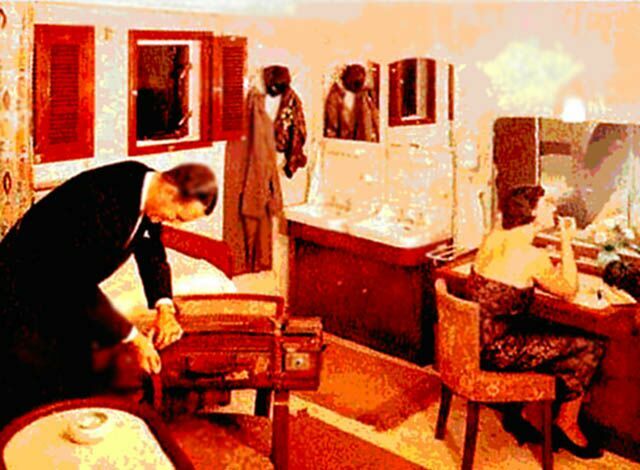
A de-luxe twin outside Cabin No 1 (post war) with a bath &
WC on A Deck forward on the starboard side
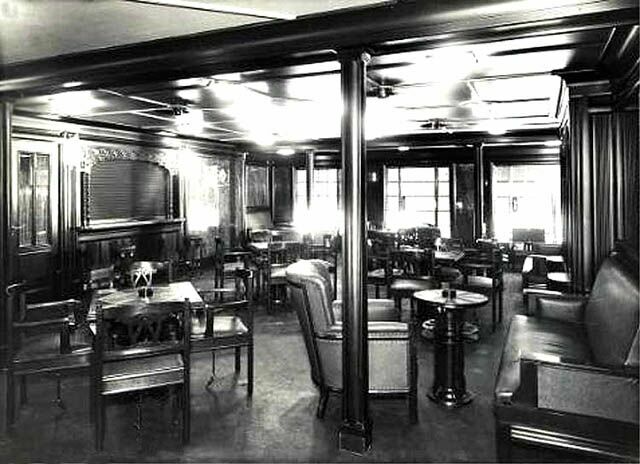
The elegant Smoke
Room aft
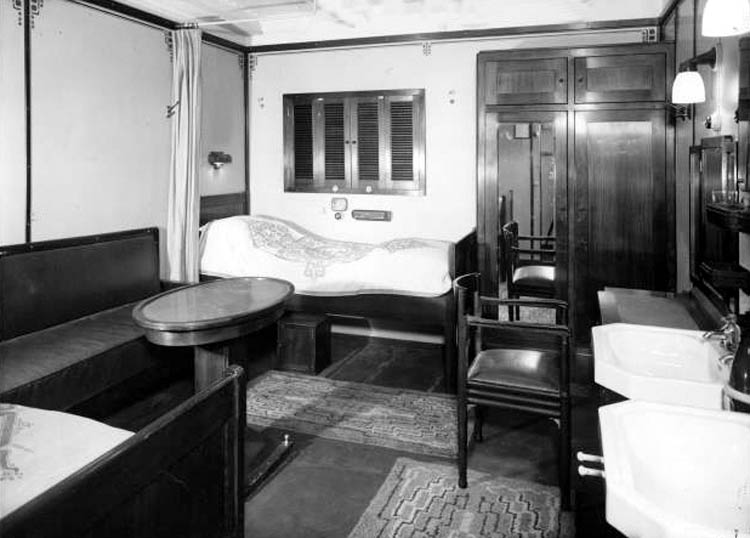
A twin bedded cabin and although sinks were located in the cabins
the majority of cabins did have a private bathroom with a WC
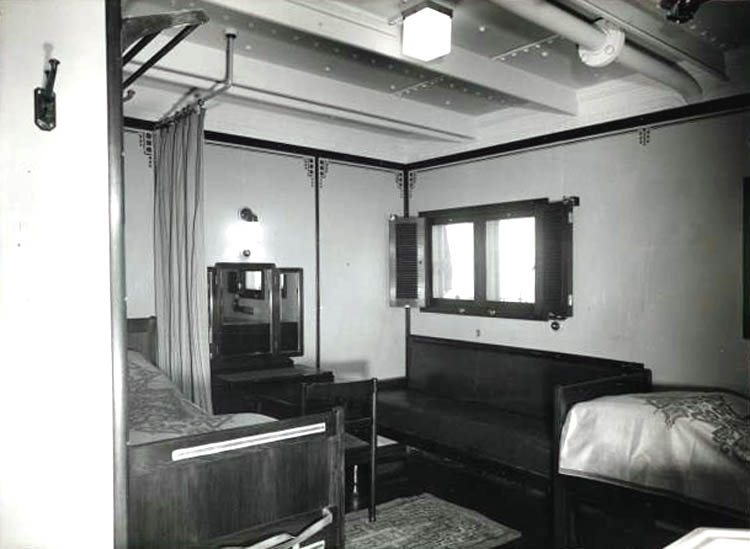
This was a
standard twin cabin without private facilities, but there were excellent
spotless public facilities
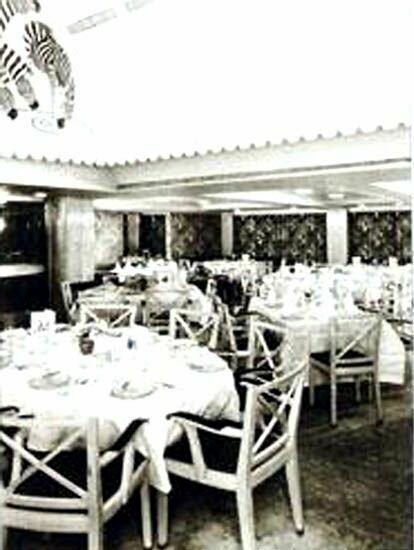
A light and bright Dining Room
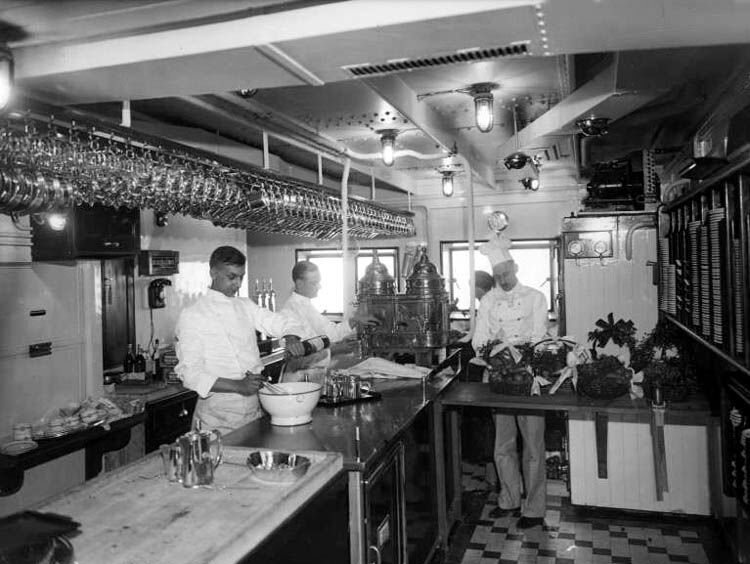
This where all the
delicious food comes from, the ships Galley
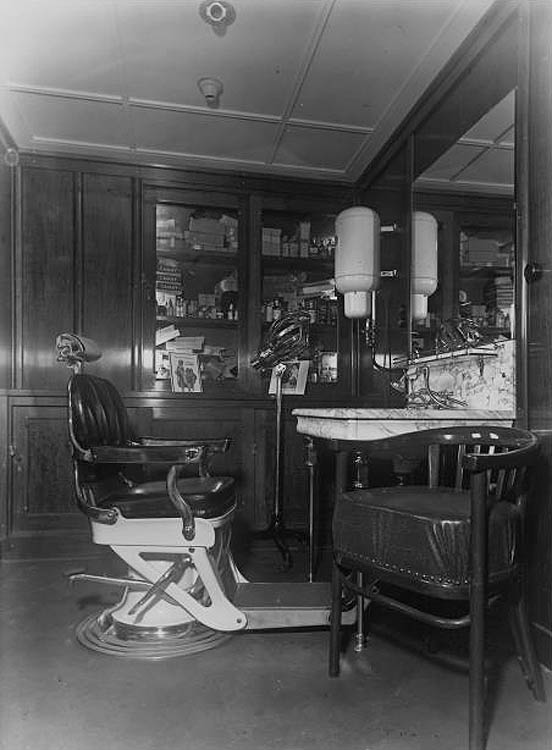
The Barber shop
Third Class:
I am sorry I have not been able to locate anything much in regard to Third Class, but their Public venues and accommodations were located in the aft section of the ship and there was a pleasant Lounge with its own Promenade as well as on a deck lower was their Dining Room and their cabins located on two decks, again all had portholes and all these accommodations had typically Dutch spotlessly clean public bathrooms and facilities close by!
*********************
World War Two:
Shortly after the outbreak of the World War
Two in September 1939, “Holland Africa Line” decided to withdraw
their passenger ships from the treacherous Western European waters and to
deploy them on the Java-Pacific line. But late in 1941 something happened and she
somehow joined an
The Pensacola
The name of this convoy was a colloquialism for an American military shipping convoy that took place in late 1941 as the Pacific War commenced. The name was derived from that of its primary escort ship, the heavy cruiser U.S.S. Pensacola (CA-24). She was officially designated as “Task Group 15.5” and Army sources may use the term ‘Republic convoy’ for the senior convoy vessel.
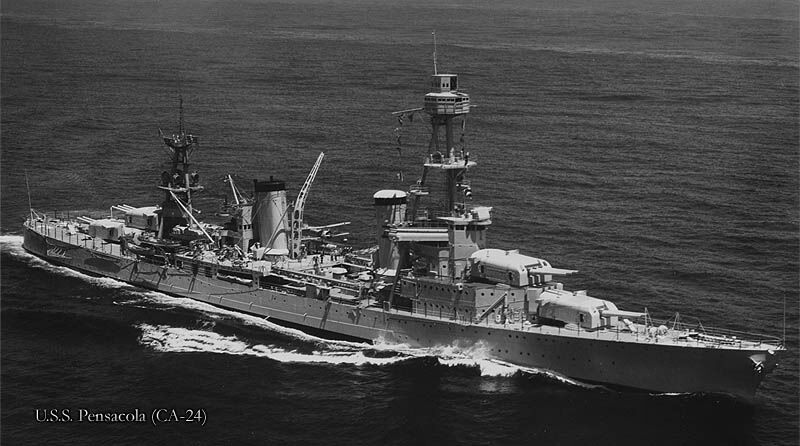
The U.S.S. Pensacola (CA-24)
The convoy, dispatched in peacetime, and it
was intended to reinforce the US Army Forces - Far East (USAFFE),
created to defend the U.S. Commonwealth of the
U.S.S.
Pensacola's convoy included the following ships; the gunboat U.S.S. Niagara; the U.S. Navy
transports vessels U.S.S. Republic and U.S.S. Chaumont; and U.S. Army troopships U.S.A.T. Willard A. Holbrook and U.S.A.T. Meigs as
well as American merchant ships “Admiral Halstead” and the “Coast Farmer” and a remarkable
Dutch merchant ship the M.S. “Bloemfontein”.
The convoy was carrying a provisional brigade from the U.S. Field Artillery Corps, made up of 2,000 National Guard troops:
The 2nd Battalion, 131st Field Artillery Regiment (Texas National Guard), and the1st and 2nd Battalions, 147th Field Artillery Regiment (South Dakota National Guard), 1st Battalion and the 148th Field Artillery Regiment (Idaho National Guard).
In addition some 2,600 U.S. Army Air
Forces personnel were also on board, along with aircraft shipped
fully disassembled in crates: such as fifty-two Douglas A-24 dive bombers of
the 27th Bombardment Group (Light) sent on the Meigs, on the
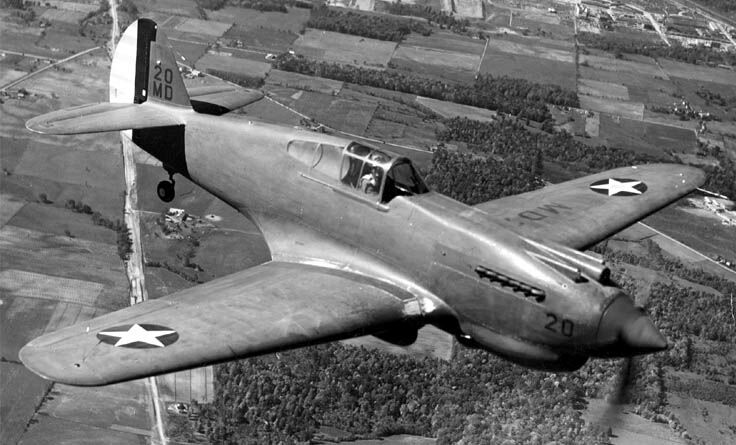
Here is one of the
Curtiss P-40 fighter planes carried by the “
Whilst forty eight pursuit pilots of the 35th PG travelled on the Republic and thirty-nine newly graduated but unassigned pilots were aboard the Holbrook.
Material transported included: 20.75 mm field artillery pieces, AA ammunition, 2,000 500-lb bombs, 3,000 30-lb bombs, 340 motor vehicles, 9,000 barrels of aviation fuel, 500,000 rounds of .50 calibre ammunition and 9,600 rounds of 37 mm anti-aircraft shells.
At 0800 hours on December 23, 1941, S.S. Coast
Farmer stood in and was moored. At 0923 hours on December 23, 1941, U.S.S.
Pensacola left
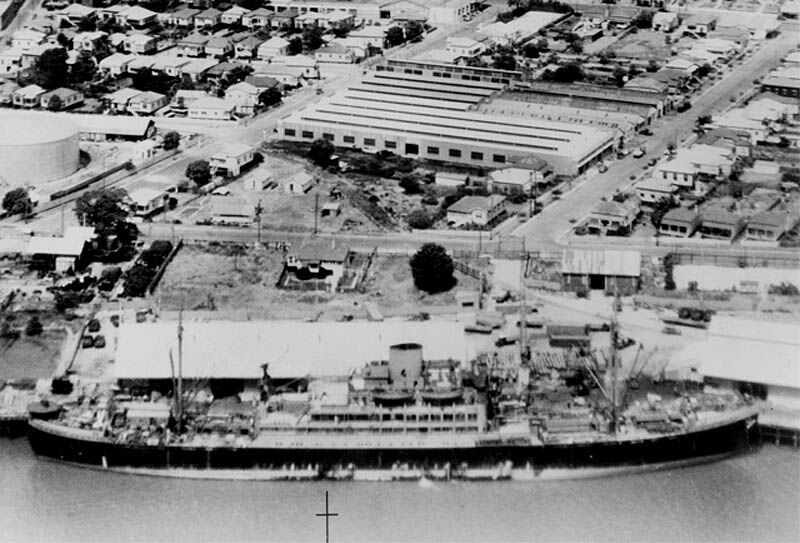
M.S. Bloemfontein
at
With thanks to www.awm.gov.au
The “
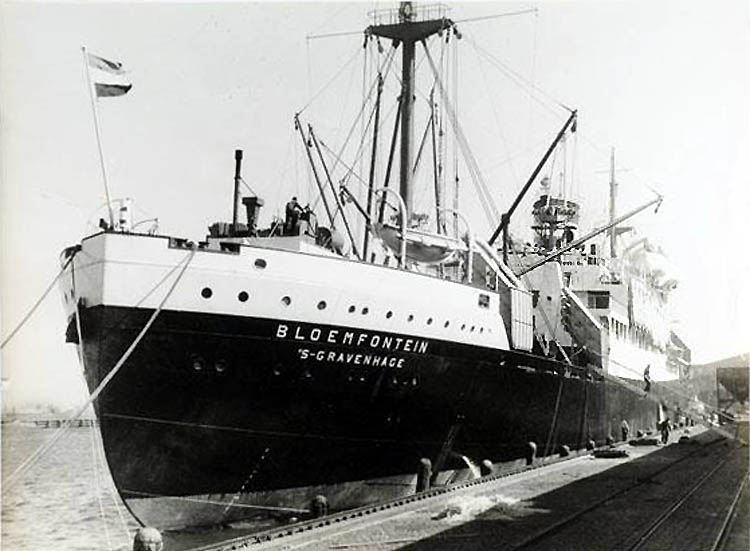
A stern view of
the “
As she had been such a useful ship in so Many
ways, the “
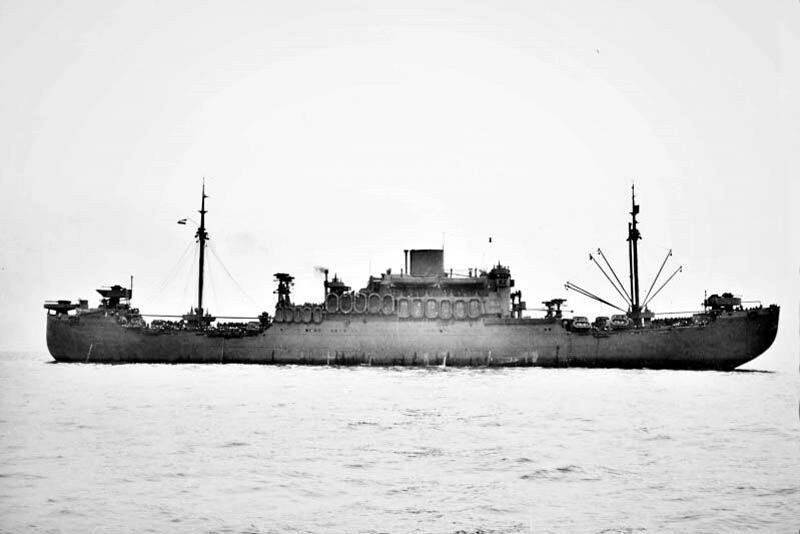
Now looking at a
very different ship, “
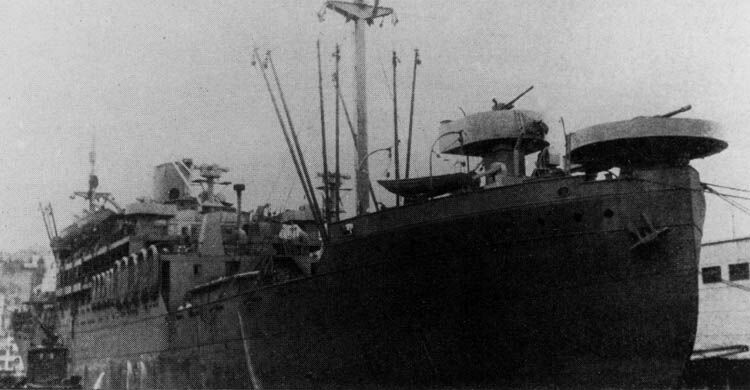
A good view of her sun placements these were two 105 mm stern guns
I was unable to locate any details of any of the other armaments on board
The “
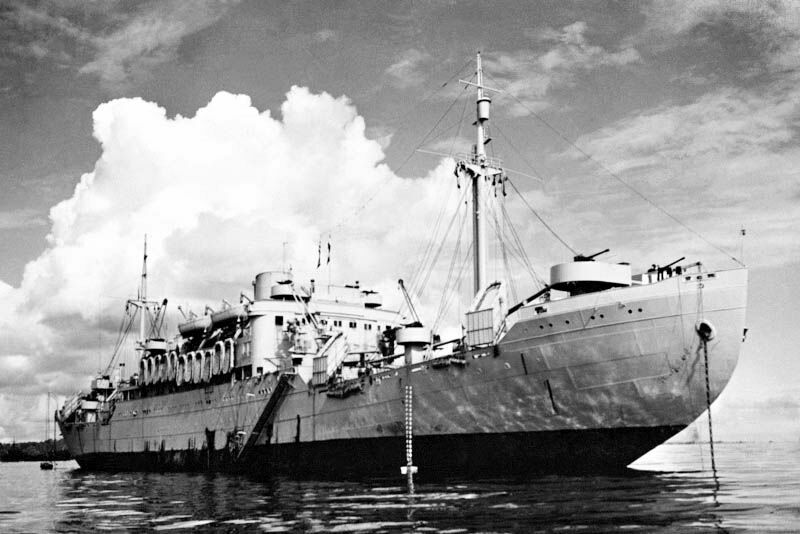
Her gun placements are clearly seen on this photograph
On December 11, 1945, the “
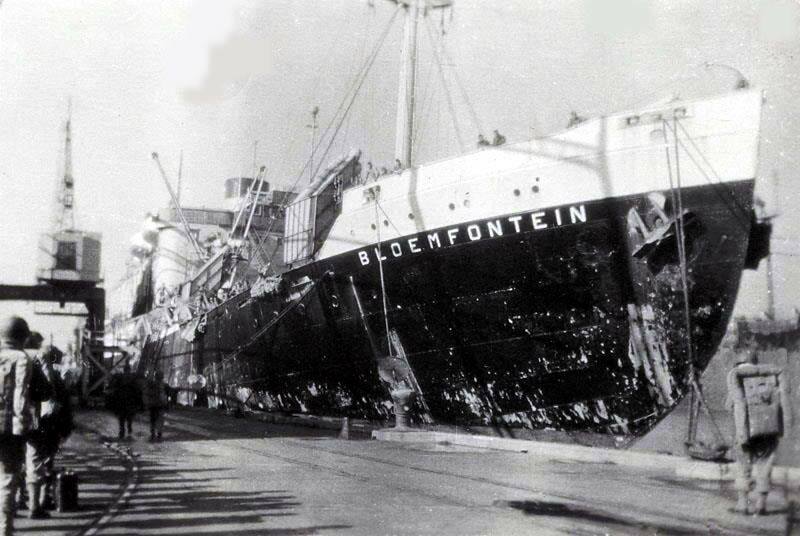
“
Her Post War Duties:
After having arrived in
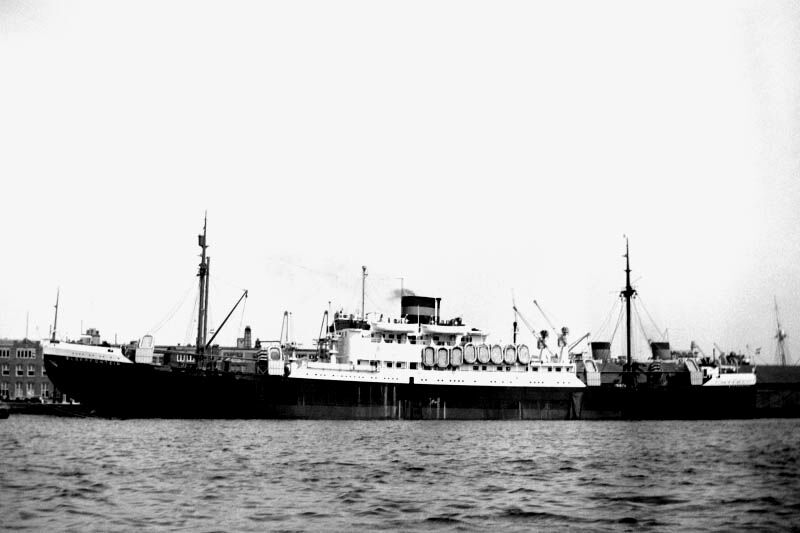
She is seen here
at
Later in 1947, the “
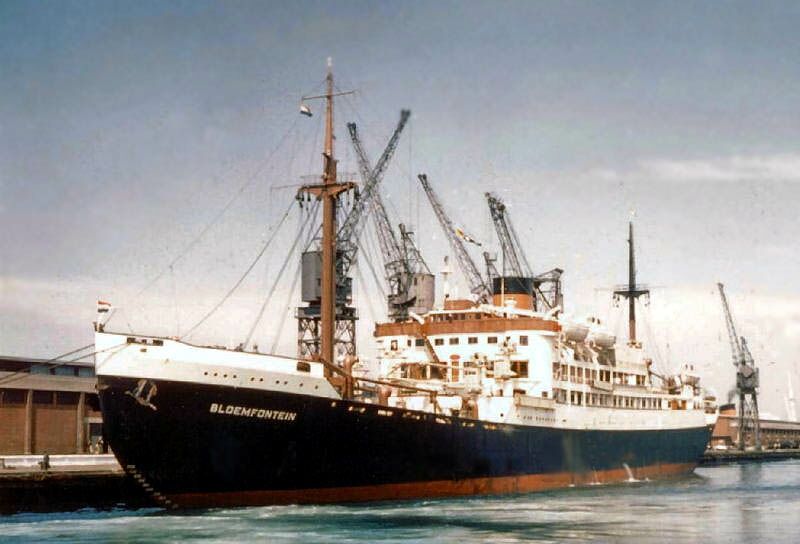
The refitted M.S.
Bloemfontein is seen in
M.S. Bloemfontein returned to her original services, which commenced on September 13, 1947, but she would be now departing Amsterdam and would be sailing via Hamburg, etc;
New Schedule: Amsterdam, Hamburg, Antwerp, Amsterdam, Southampton, Cape Town, Port Elizabeth, East London, Durban, Lourenço Marques, Beira.
Return voyages:
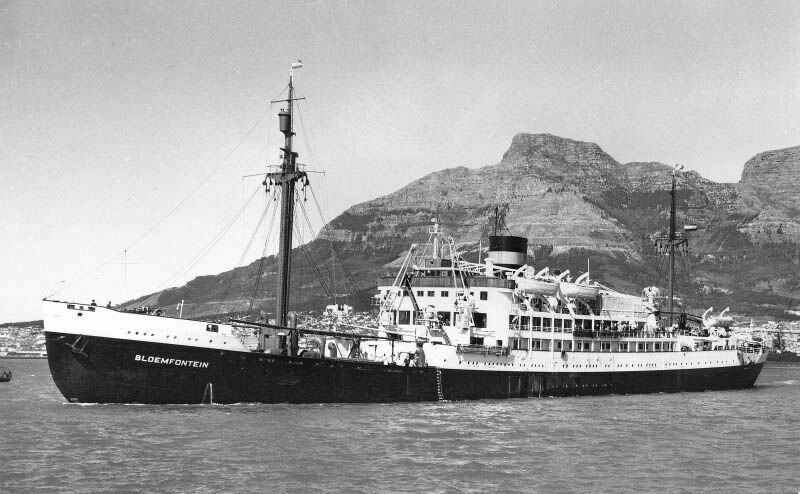
The fully laden
with cargo Post War “
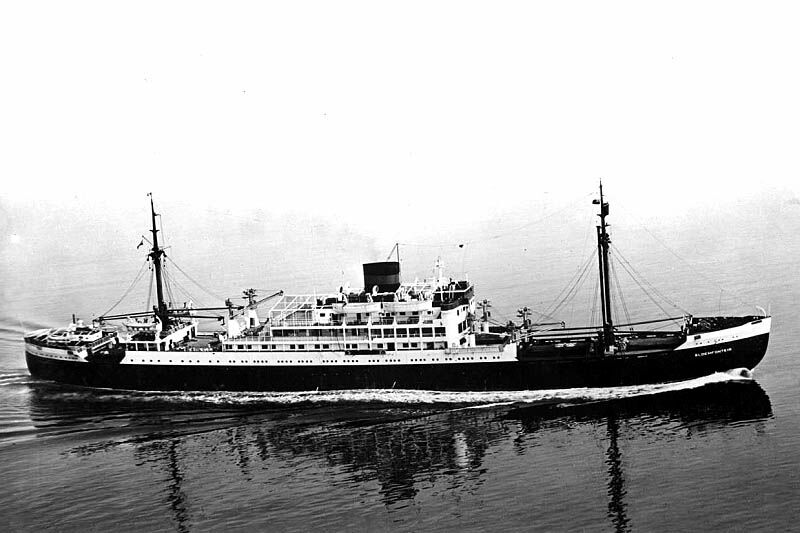
She is still a fine looking ship even towards the very end of her career
Finally in February 1959, the “
Part Two
M.S. Jagersfontein:
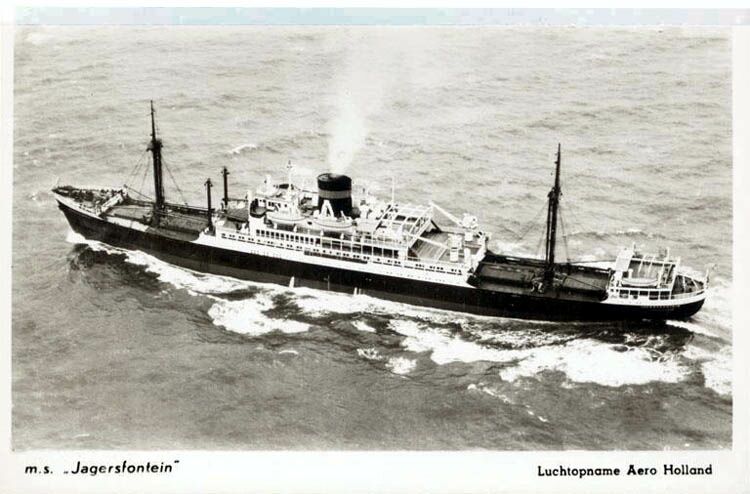
The “Jagersfontein” was laid down at the same shipyard just a little under two months later than her sister on October 17, 1933 in yard 229, and her construction was equally as fast.
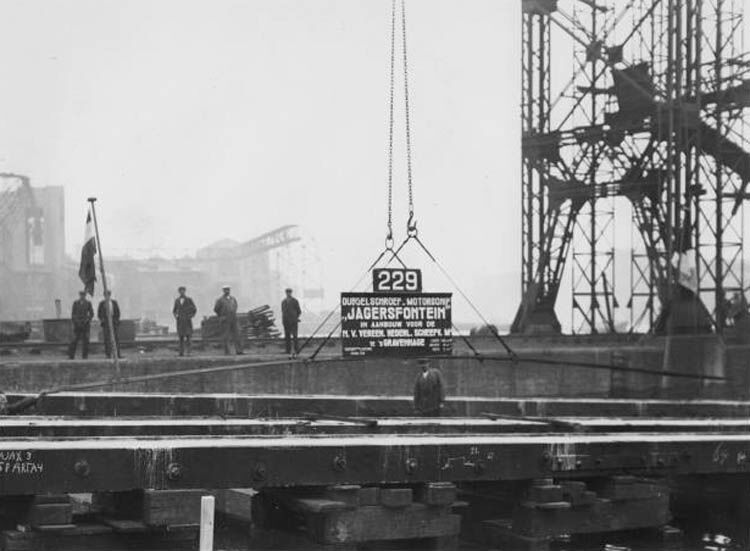
The laying of the keel on October 17, 1933
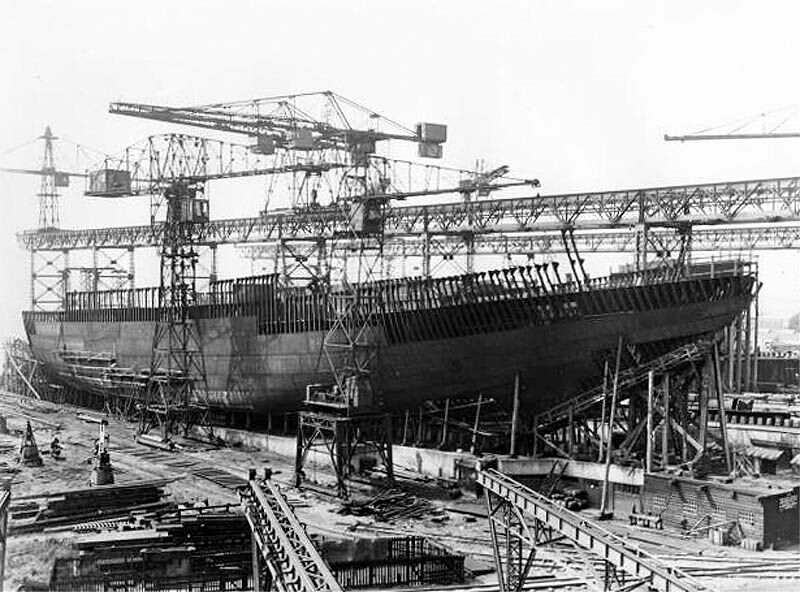
Her hull is well
on the way by April 30, 1934
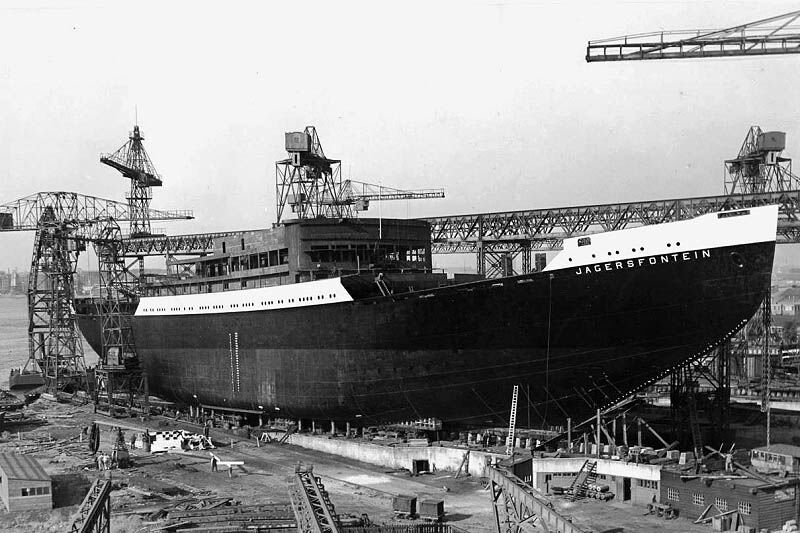
And by late May
her three deck superstructure up and finished, except for her bridge beck, and
aft sections
This event took place on July 21, 1934, and there was a massive crowd of people at hand to witness this event as well as the countless numbers of company and other officials, etc.
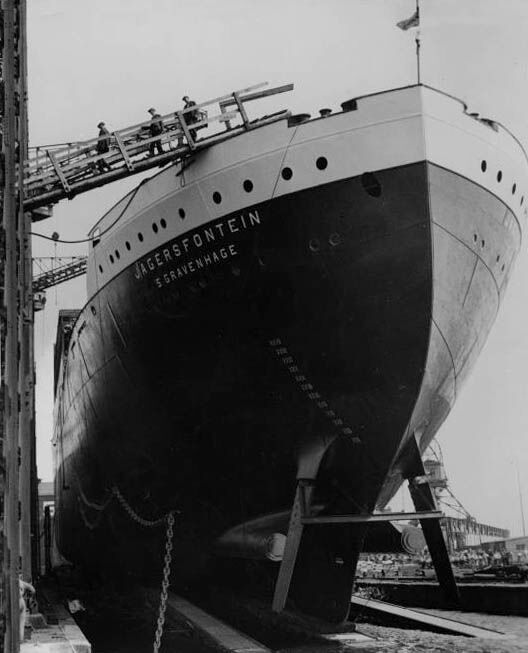
Here we see the stern of the ship as the last of the workers leave the vessel
And of course here we see her twin unusual rudders, which are in a locked position for the launch
The naming of the “Jagersfontein”
was going to be performed by Mrs E. W. Dijkstra-Viruly,
who was wife of one of the VNS Directors at the shipyard in
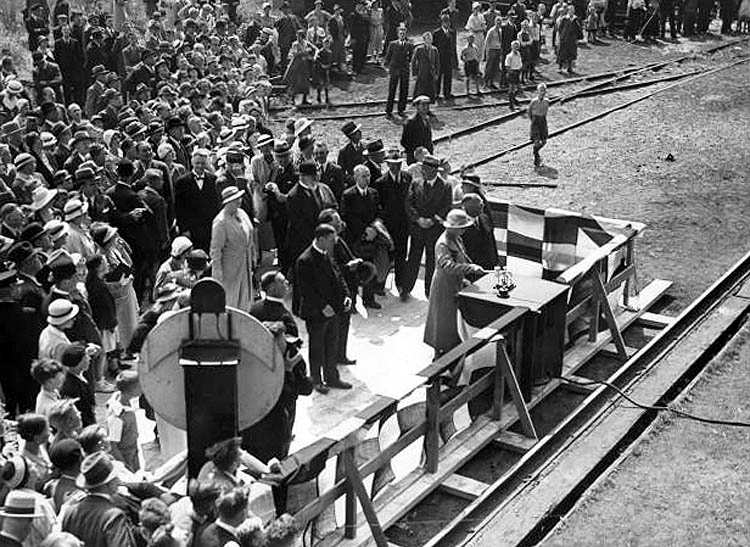
Here we see Mrs. Dijkstra-Viruly officially naming the “
After the naming, the actual launching was
done in the same manner as her sister a little earlier, and this time it would
be done by the means of a recording made by the Prime Minister of South Africa,
General J. B. M. Hertzog KC in
Thus the entire ceremony was being held at two
locations, the naming in the
According to “Schip en Werf” (Ship and Wharf) a magazine published in 1934 about shipbuilding, etc, they gave a full description of how it all came together and it is certainly very fascinating; and the following is a translation of it;
“This was something very unusual: for a
gramophone record had been produced, which produced just one sustained
tone. This was connected, by means of an electric pick-up, to the same
telephone line by which General Hertzog’s
speech was transmitted from
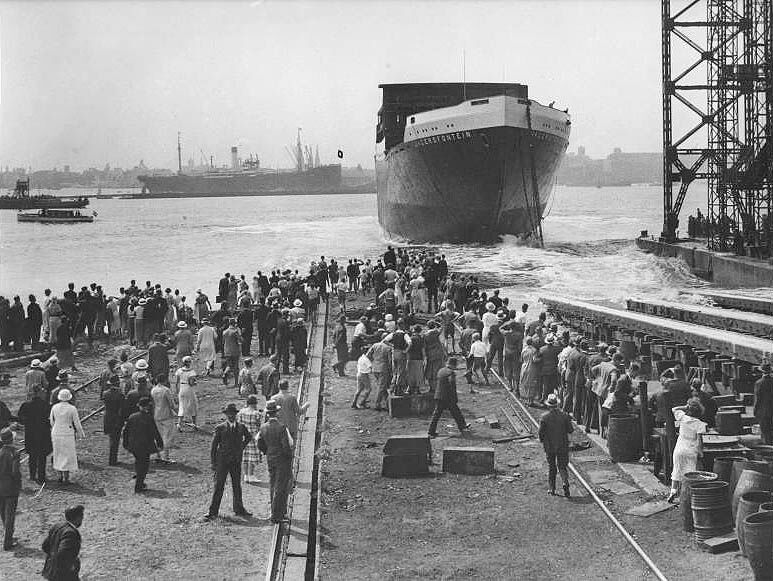
Now that is how to
launch a ship from the other side of the globe
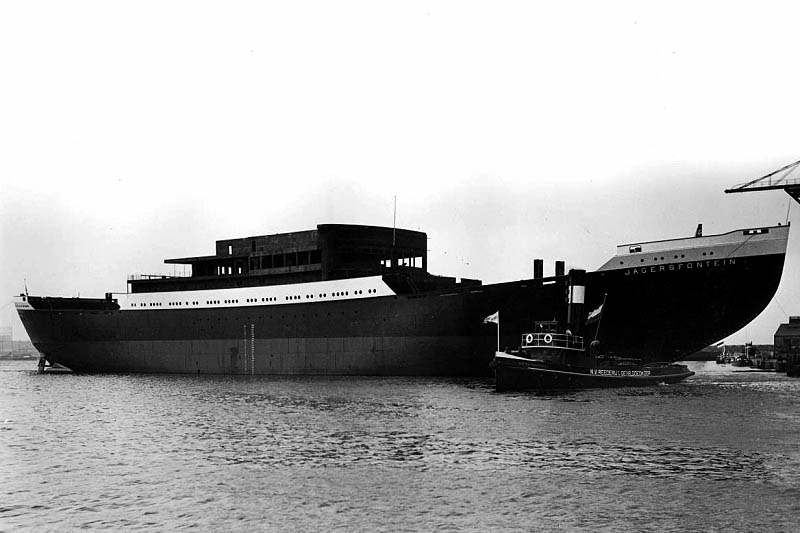
Once in the River she
was taken in tow and taken to the shipyards Fit-out berth to be completed
December 18, filled with many guests she
departed and headed down the ‘Noordzeekanaal’
and out to the
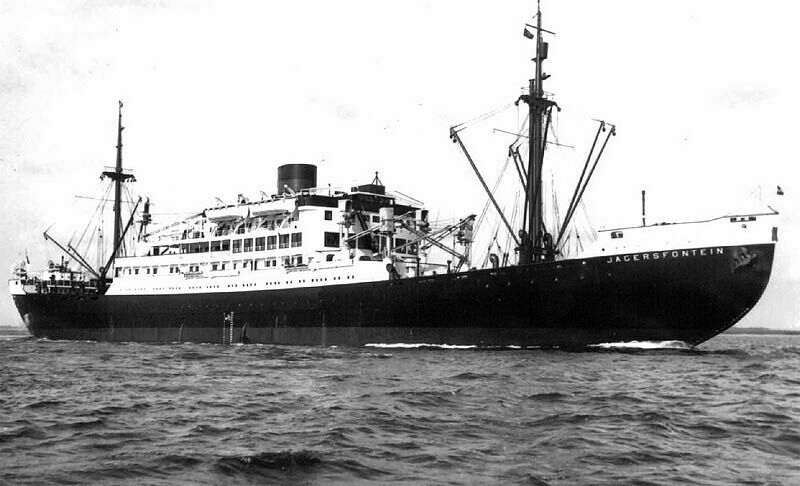
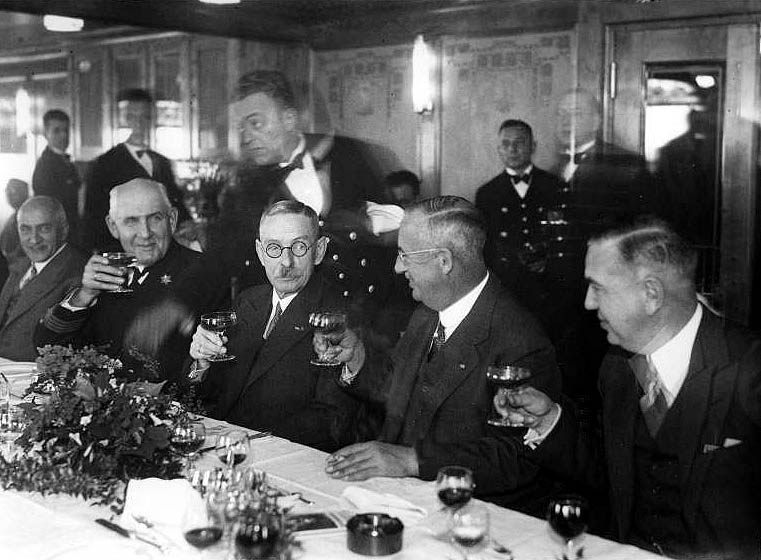
Above &
below: Events all part of the festivities of the
official handover of the ship from the yard to her owners
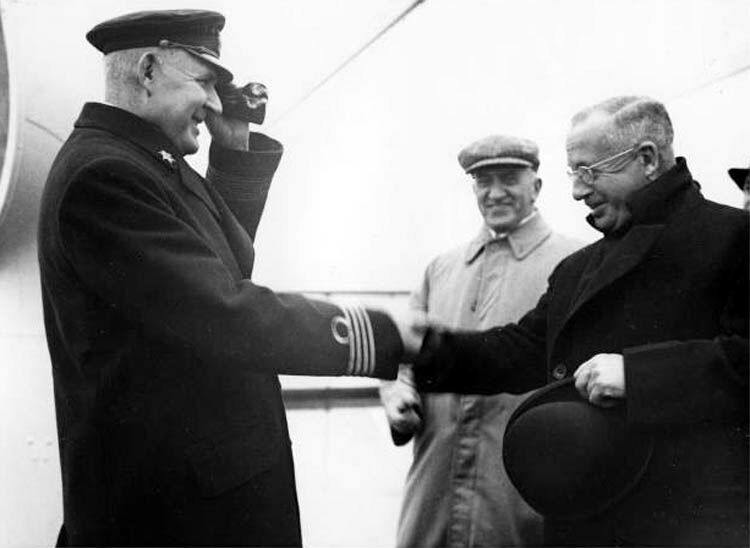
Her Maiden Voyage and Schedules:
Later in the afternoon she arrived in Amsterdam and as with all ships, she was made ready, crewed up, fully stocked, and accommodations made up to perfection for her passengers on her big day when she will depart on her maiden voyage.
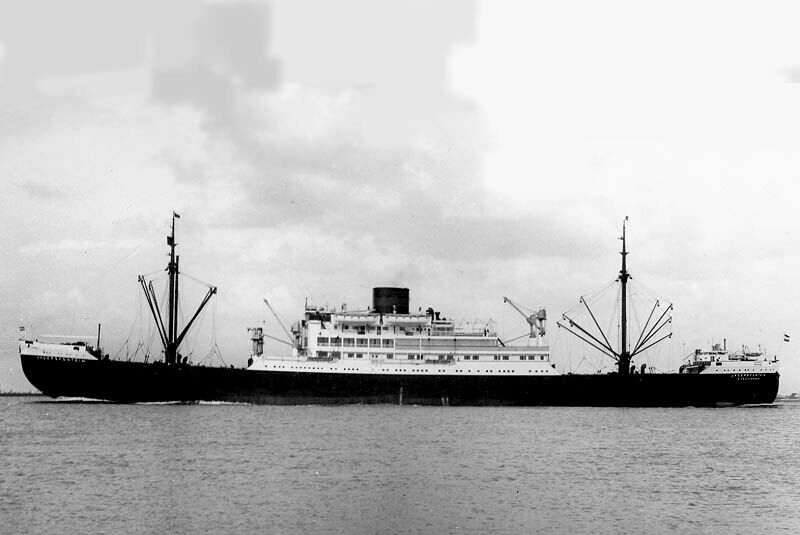
M.S. Jagersfontein
heads for
The day finally arrived when her excited
passengers had all boarded, and their guests had a good look around the
lounges, and their cabins, etc, and had a drink in the lounge, but then came
the final announcement: “This is the final call, all visitors please go
ashore now the ship is about to depart!” One the gangways were lifted,
she departed late in the afternoon of December 24, 1934 and headed for
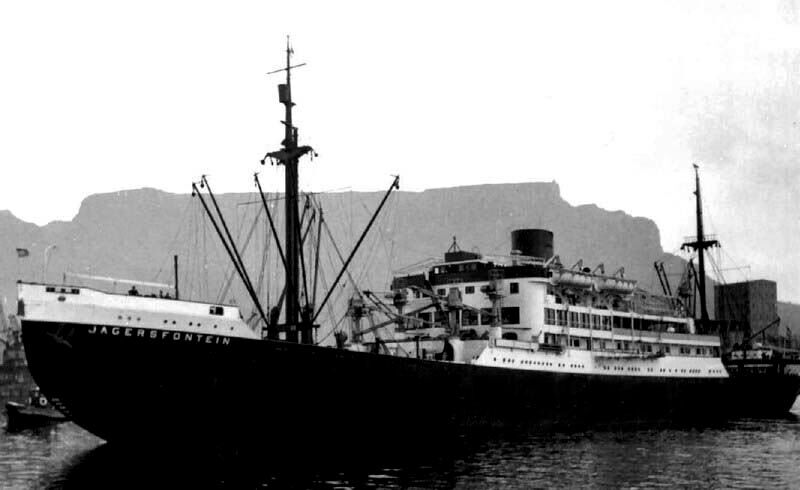
She is seen at
Her schedule;
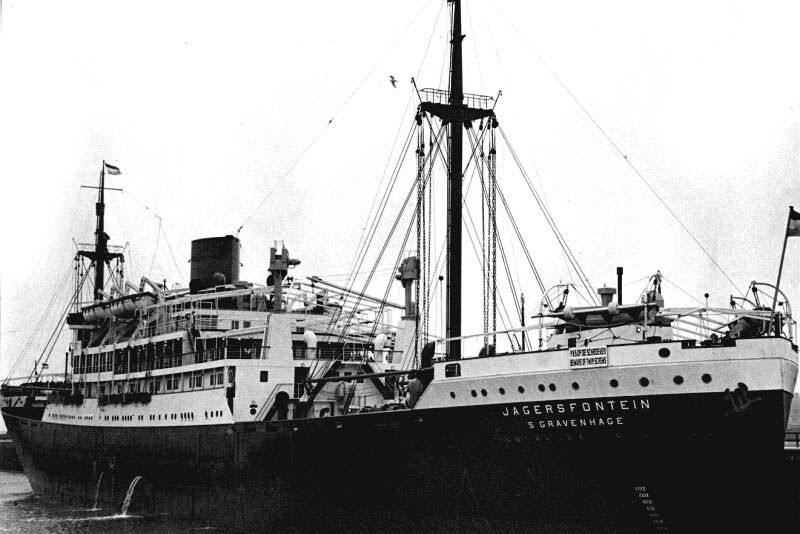
A good stern view of the “Jagersfontein”
As we all know after just four short years of her at sea, things started to get out of hand in Europe as the Second World War was about to break out.
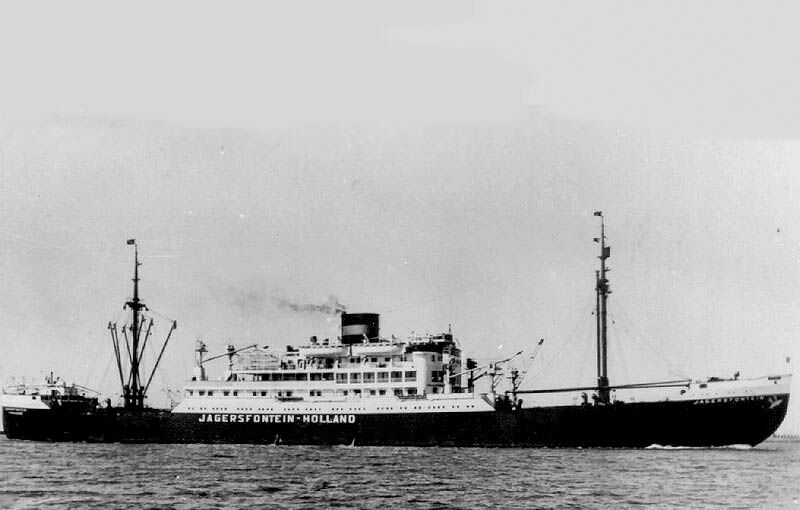
The M.S. Jagersfontein is seen here in 1939 and is seen with her Dutch neutrality signage
World War Two and Her services:
The
On July 10, 1941, the Jagersfontein departed
*But the A.V.G. Passengers – who were they?: They were the First “American Volunteer Group” (A.V.G.) of the Republic of China Air Force, nicknamed the ‘Flying Tigers’, who were formed to help to oppose the Japanese invasion of China. They operated during 1941 and 1942; it was composed of pilots from 1, the United States Army Air Corps (USAAC), 2, Navy (USN), and 3, Marine Corps (USMC), and was commanded by Claire Lee Chennault, who won the following Distinguished Medals; ‘Distinguished Service Medal’ (DSM), ‘Navy Distinguished Service Medal’, ‘Legion of Merit’ (LOM), 2 x ‘Distinguished Flying Cross’ (DFC)
Even as she passed beneath the
In spite of ‘Radio Tokyo’s’
threat, M.S. Jagersfontein reached
M.S. Jagersfontein continued to fulfil her duties in what could be called operating in very calm waters indeed! Well that was until December 1941 when she really entered the war-zone hard to say the very least, and I do mean she was now in the very heart of it!
Then
There Was Hell in Paradise
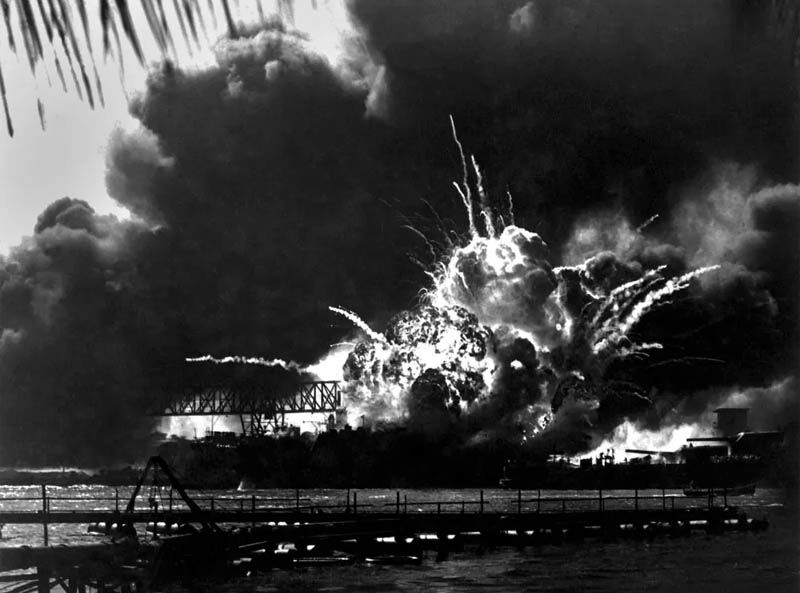
It was Sunday, December 7, 1941, and Captain
Walter Bahr a pilot from
Out at sea he boarded the
“Jagersfontein” at 0900 hours, which was under the command of
Captain Brouwer, and she had just arrived from the
west coast of the
Captain Brouwer who was without a doubt a brilliant and a shrewd man somehow managed to get his ship safely to the appointed dock and all passengers were taken off as quickly as possible. With all those bombs falling so close to her it was amazing that she survived and was not destroyed and was sunk. Afterwards, if they had not done enough, all the crew as well as all the ships passengers donated desperately needed blood for the many wounded Americans, the captain had gone to see the passengers and requested if they would be so kind and assist as there was a great need, and everyone single one did! When American officers later complimented him on all of his actions, he simply said, “Well, that’s my job”.
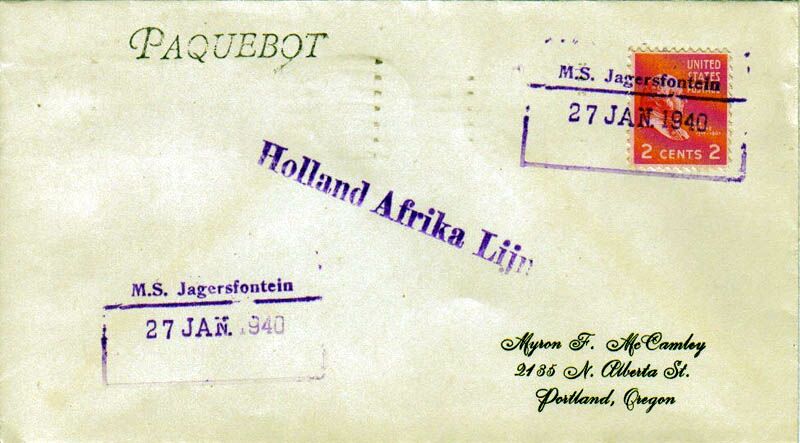
An envelope postmarked on board the “Jagersfontein” on January 27, 1940
Thus although she operated for military and passenger purposes, she remained a civilian ship
On December 20 the M.S. Jagersfontein left
Amazingly, on February 27, 1942, the
“Jagersfontein” escaped another disaster for she could have been
sunk again. Whilst a battle in the
The Jagersfontein’s Tragic Final Curtain:
On Thursday June 18, 1942 the “Jagersfontein” under the Command of Captain M. A. van der Est departed Galveston U.S.A. and she was bound for Liverpool U.K. Onboard was a complement of 220 persons, and she was carrying a general cargo of 9,000 tons, which included lead, copper, resins, cotton and timber.
Eight days later on Friday June 26, 1942 at
0930 hours the unescorted “Jagersfontein” did not know she was
being stalked by a German Boat the U-107, and suddenly she was suddenly
struck by one of two torpedoes, which had been fired when she was around 500
miles east of

The first torpedo struck her on the portside
between holds 4 and 5 and destroyed the bulkhead. The explosion was weakened
somewhat by the cotton in the hold, although distress signals were sent
immediately and the master attempted to reach
But sadly, soon her rudder jammed as the ship commenced to sink slowly by the stern and then her engines broke down at 1215 hours. Thus the Captain decided that the ship had to be abandoned by the 98 passengers, 108 Dutch crew members, 14 gunners and (86 U.S. Army officers and 12 civilians, among them women and children) in four lifeboats.
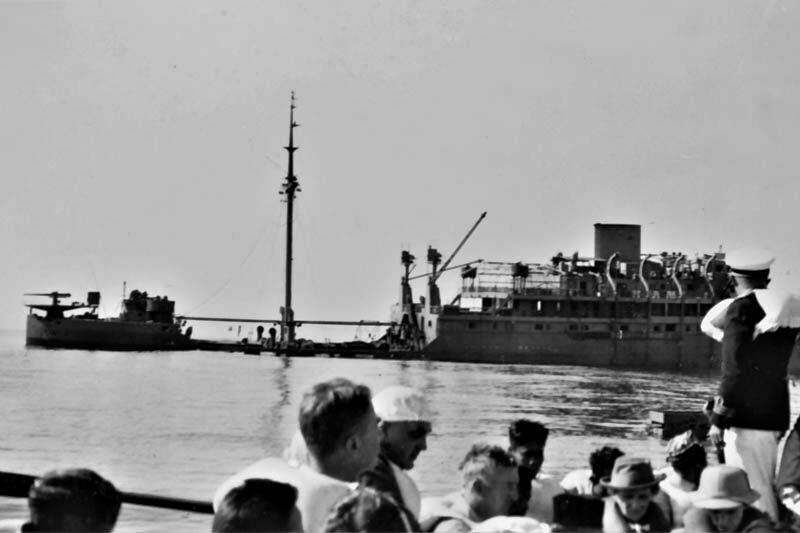
Passengers and all
the crew have abandoned the “Jagersfontein” as she is so badly
damaged that she will sink
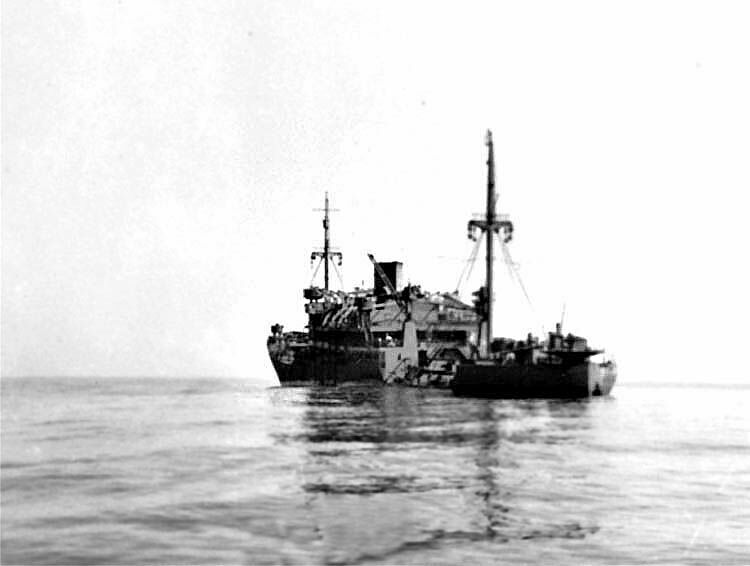
As we can see she is now so low in the water that her hold deck is level with the ocean
Then those evil Krauts in their Nazi U-boat decided at 14.59 hours, decided to fire a coup de grace, hitting the “Jagersfontein” underneath the bridge, which caused her to sink by the stern within minutes.
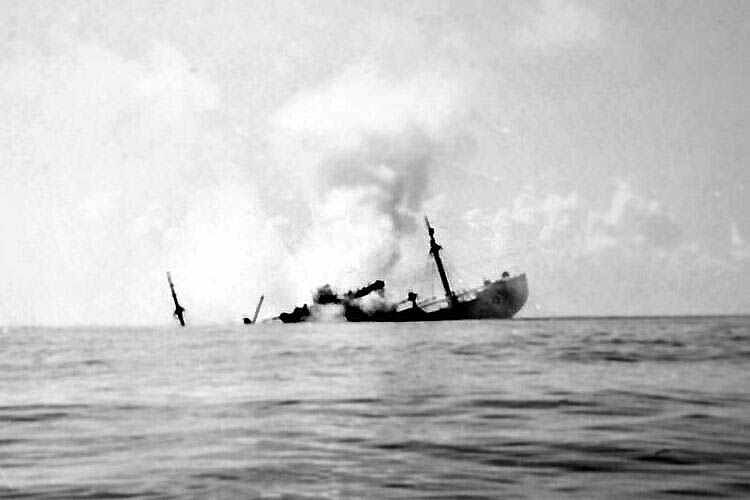
The beautiful Jagersfontein is going down by the stern at 32°02N/54°53W
Those on the lifeboats saw the U-boat
surfacing before it disappeared on a westerly course. One of the lifeboats had
a transmitter, which led the

The 4,260 GRT - S.S. St. Cergue
Later on the same
day, U.S.S. Bernadou (DD 153) with Lt. Cdr.
Robert. Edgar. Braddy,
Jr., USN in Command arrived on the scene and they took on board the 86 American
officers and the 13 gunners off the Swiss ship and departed and landed them at
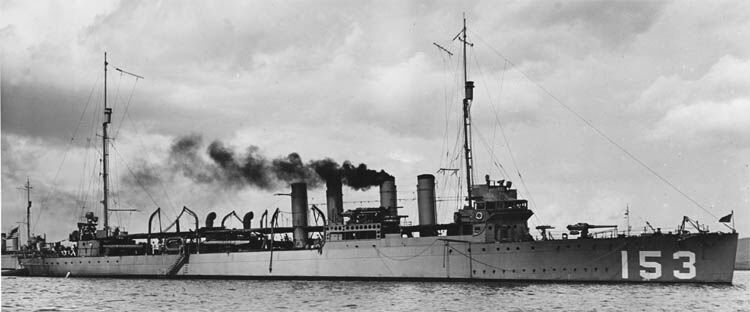
The S.S. St. Cergue proceeded
with the remaining survivors to
In Conclusion:
Although the wonderful
“Jagersfontein” (2) had just a relatively short life of almost 6½
years at sea before she was so tragically destroyed by that U-Boat, but there
are countless of her passengers who so fondly remember her as a wonderful,
friendly and a fine ship, that provided them with a wonderful happy voyage to South
Africa or back to Europe, whilst visiting so many interesting ports of call, as
well as the excellent service and the amazing cuisine they received during
their voyage. She remained greatly loved and I over the years received many
emails from family members and even from those who actually sailed on her who
had nothing but praise of the “Jagersfontein”, as well as the
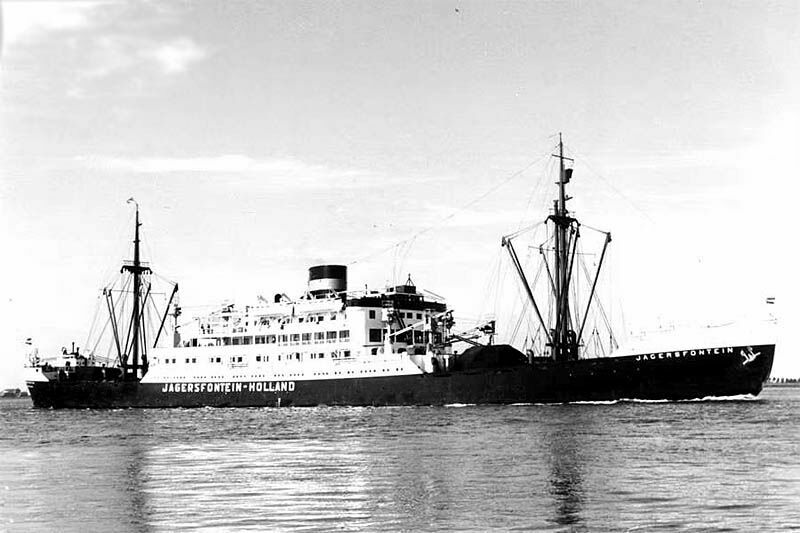
Specifications &
Details of These two fine Ships:
Names:
1
2: Is the Jagersfontein.
No number means: It applies to both ships.
Owner:
Built by: Nederlandsche Scheepsbouw
Mij NV,
Laid Down: 1. August 26, 1933.
. 2. October 17, 1933.
Yard No: 1. 228.
. 2. 229.
Registered at:
ID: 1. 1007.
. 2. 3122.
Call Sign: 1. PDDV.
. 2. PEYW.
Type: Passenger-Cargo
Ship.
Launched: 1. June 16, 1934.
. 2. July 21, 1934.
Completed: 1. October 18, 1934.
. 2. December 16, 1934.
Sea Trial: 1. October 20, 1934.
. 2. December 18, 1934.
Maiden Voyage: 1. October 27, 1934.
. 2. December 24, 1935.
Tonnage: 1. 10,075 GRT,
1938: 1. 10,081 GRT.
1947: 1. 10,473 GRT.
Tonnage: 2. 10,077 GRT, 6,164 NET, 10,515 DWT.
1938: 2. 10,083 GRT.
Length: 487.20 ft - 148.5 m.
Breadth: 63.25 ft - 19.28 m.
Draught: 30.83 ft - 9.4 m.
Engines: 2-stroke single-acting Stork Diesel’s.
. 12 cylinders 8300 BHP.
Additional Info: Two 6-cyl. AEG Hesselman Diesels.
Propellers: 2.
Speed: 16 Knots service speed, 17.3 Knots Maximum.
Accommodations: 81 First Class and 32 Third Class.
Crew: 157.
Fate: 1.
The “
. 2.
On June 26, 1942 the “Jagersfontein” was torpedoed by a U-Boat,
U-107 which saw her sink by the stern, all on board took to the lifeboats and
were rescued by a Swiss vessel and an American Destroyer.
Page One … M.S.
Bloemfontein (2) and the M.S. Jagersfontein (2) of 1934 (this page).
Three Fontein Ships … History of the M.S. Klipfontein and her sister ships.
Visser Family
Voyage …
To
M.S. Randfontein (2) … Of 1958 page.
Fontein Photo Page … And memorabilia and brochures, etc.
Also Read: V.N.S. Freighters from 4 to 12 passengers.
SS Abbekerk … The
delightful V.N.S. 8,336-ton passenger-cargo ships.
Remembering the Memorable …
M.S. Bloemfontein & Jagersfontein of 1934
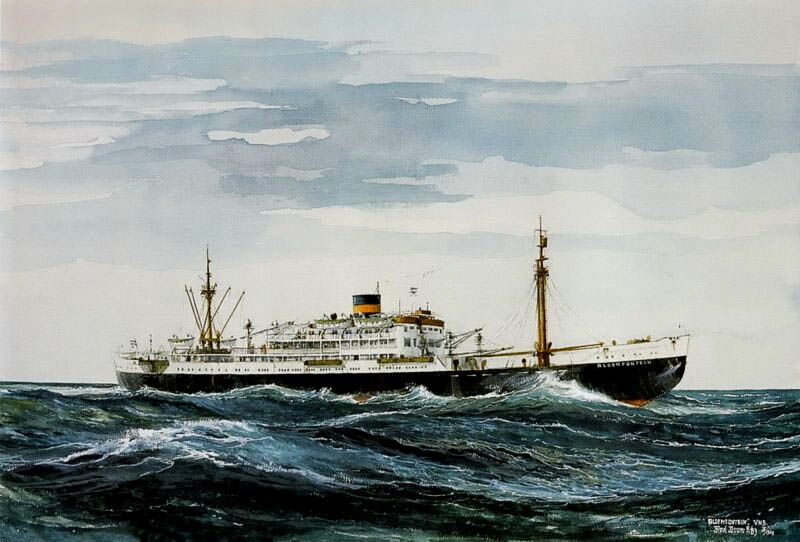
A delightful
artist version of the
This excellent
panting was done by a Fred but I cannot read the surname
If anyone can
assist with this fine artists name I would greatly appreciate it
The image was sent
to me by a supporter, but without details
*********************
“Blue Water Liners sailing to the distant shores.
I watched them come, I watched
them go and I watched them die.”
Featuring over 1,435 Classic Passenger Liners, Passenger-Cargo Liners & Classic Cruise Ships!
Or ENTER HERE
For interest: Sadly an email service to ssMaritime is no
longer available, due to the author’s old age and chronic illness as well
as being disabled, etc. In the past ssMaritime received well over 120 emails
per day, but
*********************
ssMaritime.com & ssMaritime.net
Where the ships of the past make history & the 1914 built M.S. Doulos Story.
The Author has been in Passenger Shipping & the Cruise Industry for well over 60 years
In addition he was the founder of “Save the Classic Liners Campaign” in 1990.
Please Note: ssmaritime and associated sites are 100% non-commercial and the author seek no funding or favours of any shape or form, never have and never will!
Photographs on ssmaritime and associate pages are by; the author or from the author’s private collection. In addition there are some images that have been provided by Shipping Companies and private photographers or collectors. Credit is given to all contributors. However, there are some photographs provided to me without details regarding the photographer/owner concerned.
This notice covers all pages; although, and I have done my best to ensure that all photographs are duly credited and that this notice is displaced on each page, that is, when a page is updated!
ssMaritime is owned
& © Copyright by

